

ANNUAL REPORT 2023



ANNUAL REPORT 2023
Customer
Connecting
Approach
Material
Environmental Social
Governance
Metrics
Sustainability


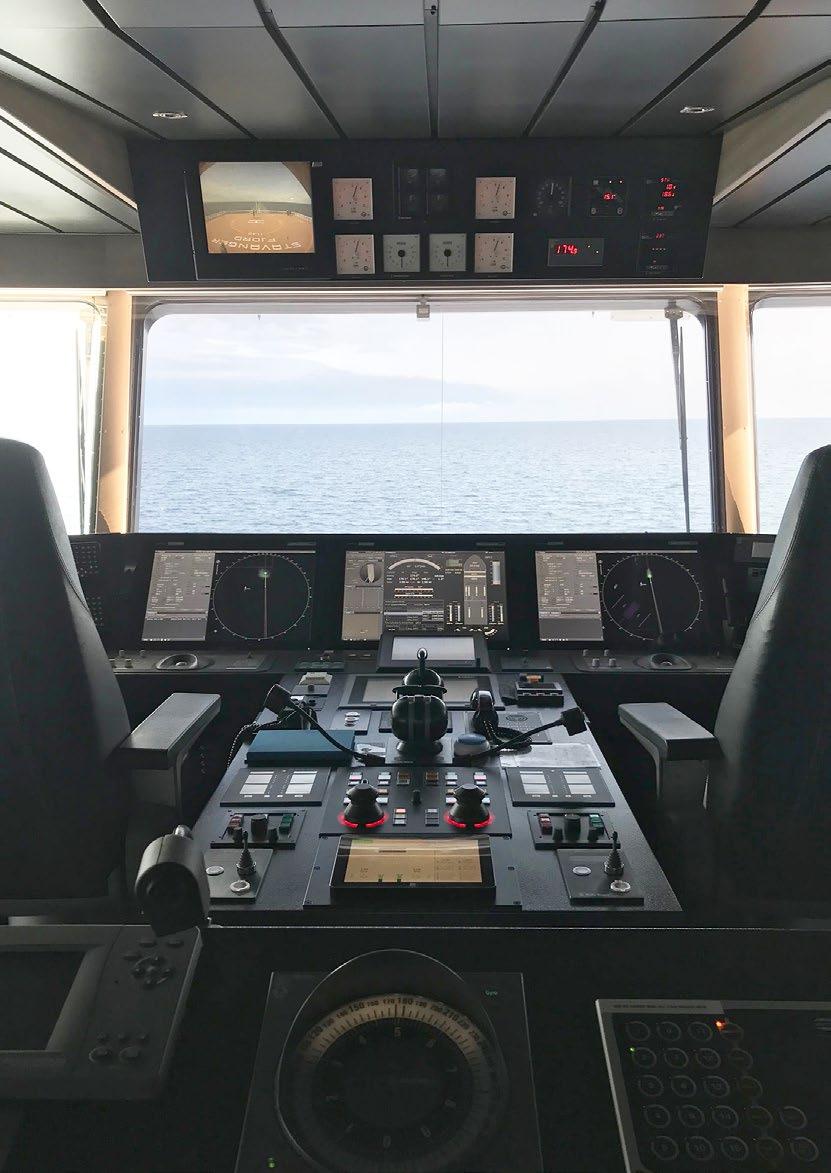
2023 has been a year of significant changes in Fjord Line. We have successfully completed strategic initiatives and investments to strengthen our business in a challenging geopolitical and macroeconomic environment, and to strengthen and extend our customer offerings to deliver even better, more, and new customer experiences in line with our new strategy.
AS WE NAVIGATE through an ever-evolving landscape, our focus remains steadfast to reinforce excellence in all our business fundamentals. Our strategic imperative is clear: to establish a sustainable business model anchored around our core business; transportation of passengers and goods, mini-cruises, and holiday-travel.
We are determined and strongly committed to implement strategic initiatives to secure a sustainable strong development of Fjord Line to the benefit of all our stakeholders.
We have successfully completed extensive strategic initiatives and investments in 2023, to ensure the solid foundation for Fjord Line’s future development, profitability, and growth. This includes strategic initiatives such as; rebuilding LNG-ships from singlefuel to dual-fuel engines, route discontinuations, and introduced new customer offerings on our south corridor between Hirtshals and Kristiansand including a new domestic route between Kristiansand and Stavanger/Bergen in the beginning of 2024.
In October 2023, Fjord Line discontinued the operations on the route between Sandefjord in Norway and Strömstad in Sweden and MV Oslofjord will be disposed of. The discontinuation was
driven by strategic considerations to align our customer offerings with our vision and long-term strategy, anchored around profitable development of our core business on the routes between Norway and Denmark. The discontinuation led to organizational changes as we closed the Sandefjord and Strömstad offices, moving towards a leaner organizational set-up for our entire business. This unfortunately led to the departure of many of our valued colleagues.
Our new foundation – “New Fjord Line” – is an essential milestone towards increased competitiveness, profitable growth, and scale. With this foundation in place, we are now prepared to advance the development of Fjord Line further. Moving forward, we will implement our new strategy for the next 3 years, introduced at the end of 2023.
In December 2022, Fjord Line announced the decision to rebuild our two LNG-ships MV Stavangerfjord and MV Bergensfjord from single-fuel to dual-fuel engines. A significant strategic change and investment to reduce our risk in the current geopolitical environment, caused by the terrible and devasting war in Ukraine
“New Fjord Line” - is an essential milestone towards increased competitiveness, profitable growth, and scale. With this foundation in place, we are now prepared to advance the development of Fjord Line further.
and consequently causing extraordinary volatile and increased fuel price development, especially in LNG (Liquified Natural Gas). The price increases in LNG have been far higher than for traditional and less sustainable energy sources at sea and led to a dramatic increase in the energy costs for Fjord Line’s two LNGoperated ships, significantly above a financially sustainable level.
The completed engine conversions enable our two LNG-ships to switch between LNG and MGO (Marine Gas Oil). The conversion to dual-fuel engines has ensured a strong and robust operational flexibility, leading to a significant reduction in our risks and enabling a financially sustainable business operation.
Fjord Line concluded a refinancing as part of the LNG-ships engine-conversions. A refinancing and investment, where our owners and lenders through their strong commitment jointly secured the continued development of Fjord Line’s strong position.
The consequences of our two LNG-ships being out of operation for several months during 1st half of 2023 was significant for both our customers and our financial performance in 2023.
Both LNG-ships resumed operations according to plan during May and June. It was with great pleasure and celebration that we finally could welcome our customers back to MV Stavangerfjord and MV Bergensfjord and all colleagues back to a “new normal”, continuously providing strong customer experiences.
In the beginning of 2023, a permanent route change was announced for MV Stavangerfjord and MV Bergensfjord from the port of Langesund to the port of Kristiansand, when both ships resumed operation in May and June after the engineconversions. The change provides a stronger customer offering for both passengers and freight customers on our Hirtshals and Kristiansand route, the shortest sailing distance between Norway and Continental Europe. This includes higher frequencies, allyear services, and a choice of service between our ferry cruise-
ships MV Stavangerfjord/MV Bergensfjord and our high-speed catamaran Fjord FSTR.
When MV Stavangerfjord and MV Bergensfjord, resumed operation, we also introduced new improved services and facilities on both LNG-ships, as we spent the time in dock purposefully, to implement new outdoor lounges on Deck 10 and new indoor lounges on Deck 7, on both ships.
In January 2024, Fjord Line further enhanced our customer offerings with the launch of a new evening departure between Denmark and Norway on the Kristiansand - Hirtshals route and a new Norwegian domestic route with the night departure between Kristiansand and Stavanger and onwards to Bergen. The new departures deliver exciting opportunities for our guests. We are thrilled to enhance Fjord Lines customer offerings for both passengers and freight customers with the new requested departures, which will also allow for the transfer of even more heavy freight traffic from land to sea. Fjord Line accounts for a significant portion of the important freight transportation between Norway and Denmark and aims to continue this by providing more and even better customer offerings.
In the face of a difficult and challenging market environment with high inflation and rising interest rates impacting consumer spending and growth, our focus remains steadfast: to reinforce excellence in all our business fundamentals and consequently enhance our competitiveness. We want to be the preferred choice.
As mentioned, our new foundation - “New Fjord Line” - is an essential milestone towards increased competitiveness, profitable growth, and scale. With this foundation in place, we are now prepared to advance the development of Fjord Line further.
At the end of 2023, we launched our new strategy 2023-2026 – a journey towards increased differentiation and competitiveness based on delivering even better, more, and new customer
The center of our strategic focus is to secure that we make every journey better for our customers within our core business: transportation of passengers and goods, mini-cruises, and holiday-travel.
experiences. The center of our strategic focus is to secure that we make every journey better for our customers within our core business: transportation of passengers and goods, mini-cruises, and holiday-travel. We are strongly committed to deliver highquality, safe, and unique customer experiences throughout the customer journey.
Our strategic core is to provide our customers with the best of Denmark and Norway in a sustainable way. Furthermore, it should be inspiring, simple, and safe to experience Denmark and Norway for our customers and based on significant customer insights our strategic focus will also evolve towards further focus around holiday-travel packaging.
We look forward to the ongoing launch of new exciting customer offerings - also in close collaboration with strong partners.
Fjord Line continue to have a strong strategic focus and commitment towards responsible and safe business operations & maritime travel including continuous efforts to develop a modern fleet. We will continue our investments in innovative and sustainable ferry operations including using new technologies and further digitization to the benefit of our customers, stakeholders, and society.
As we reflect on the past year's accomplishments and chart our course for the future, I am filled with a profound sense of optimism. I am also humbled by the remarkable dedication, strong loyalty, and outstanding efforts of our colleagues. Their unwavering commitment to excellence, innovation, and collaboration - and always with an eye for developing and delivering the best customer experiences, has been the cornerstone of our success. Thank you! We are very fortunate to have such dedicated people and leadership in Fjord Line.
On behalf of Fjord Line, I also want to extend my sincere gratitude to all our stakeholders for crucial support, commitment, and
confidence in Fjord Line. At Fjord Line, we are proud of the role we play in society, and we are strongly committed to continue to deliver value to all our stakeholders.
In our pursuit of excellence, we continue to aspire to become Scandinavia’s best, most loved, and profitable ferry company. At the heart of our endeavors lies a profound dedication to enhance the experiences of our customers and a strong commitment towards responsible and safe business operations & maritime travel. Going forward and in line with our new strategy, we will strengthen and extend our customers offerings to deliver even better, more, and new customer experiences.
Welcome on board.

Brian Thorsted Hansen CEO
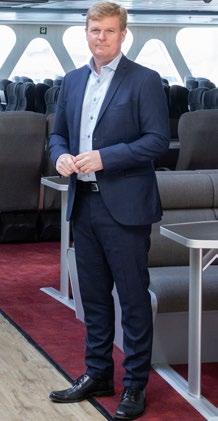
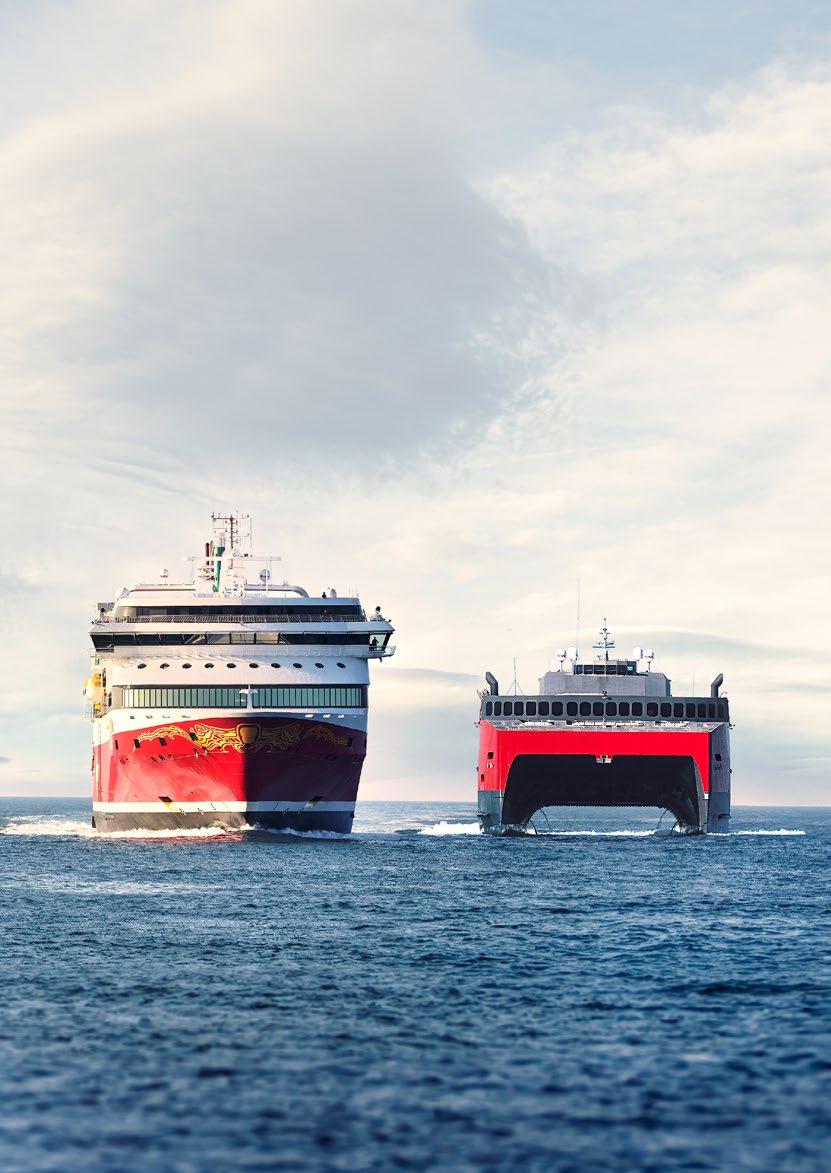
Fjord Line was founded in 1993 and is Norway’s second largest shipping company for international passenger traffic and freight transportation between Norway and Denmark.
BEING A LINK between Norway and Europe has always been important throughout Fjord Line´s history. We are proud of the role Fjord Line plays in society by providing services between coastal communities and in connecting Norway and Continental Europe.
Fjord Line operates the ferries MV Bergensfjord and MV Stavangerfjord, sailing between Bergen, Stavanger, Hirtshals, and Kristiansand, and the newly built HSC Fjord FSTR sailing between Kristiansand and Hirtshals. All vessels fly the Danish flag.
During first half of 2023 our operations with MV Bergensfjord and MV Stavangerfjord in the port of Langesund was replaced by the port of Kristiansand to secure a stronger customer offering.
In October 2023, Fjord Line discontinued the operations on the route between Sandefjord in Norway and Strömstad in Sweden and the ferry MV Oslofjord will be disposed of. The discontinuation was driven by strategic considerations to align our customer offerings with our vision and long-term strategy, anchored around profitable development of our core business on the routes between Norway and Denmark. The discontinuation also led to the closure of our Sandefjord and Strömstad offices.
Fjord Line has led the way in the green transition at sea, being pioneers within green shipping and sustainable fuels. This includes being an early adopter of Liquified Natural Gas (LNG) technology, which enables up to 25% CO2 til savingswww and
greatly reduced emissions of sulphur- and nitrogen oxides. Our fleet has a class-leading sustainability profile, and we are strongly committed to use and currently take advantage of new technologies to meet requirements for lowering our CO2emssions.
In December 2022, Fjord Line announced the decision to rebuild our two LNG-ships MV Stavangerfjord and MV Bergensfjord from single-fuel to dual-fuel engines during 1st half of 2023. A significant strategic change and investment to ensuring a strong and robust operational flexibility leading to a significant reduction of our risk especially in the current geopolitical environment. The price increases in LNG have been far higher than for traditional and less sustainable energy sources at sea and led to a dramatic increase in the energy costs for Fjord Line’s two LNG-operated ships. The completed engine conversions enable our two LNGships to switch between LNG and MGO (Marine Gas Oil). The consequences of our two LNG-ships being out of operation for several months during 1st half of 2023 was significant for both our customers and our financial performance in 2023.
In 2023, with our LNG-ships being out of service for several months due to engine conversion from single-fuel to dual-fuel engines, Fjord Line's 650 employees transported 1.2 million passengers and 30,000 freight units. Fjord Line is headquartered in Egersund with offices in Hirtshals, Bergen, Stavanger, and Kristiansand.
FJORD LINE’S VISION is to become Scandinavia’s best, most loved and profitable ferry company.
The key to be preferred – and loved – is the experience our customers gain through the entire customer journey. We are strongly committed to deliver high-quality, safe, and unique customer experiences throughout the customer journey. At the heart of our endeavors lies a profound dedication to enhance the experiences of our customers and a strong commitment towards responsible and safe business operations & maritime travel.
Our overall focus remains steadfast: to reinforce excellence in all our business fundamentals and consequently enhance our competitiveness and profitability. In our pursuit of excellence, we continue to develop our business to secure a sustainable strong development of Fjord Line to the benefit of all our stakeholders.
Going forward and in line with our new strategy, we will strengthen and extend our customers offerings to deliver even better, more,
and new customer experiences. The center of our strategic focus is to secure that we make every journey better for our customers within our core business: transportation of passengers and goods, mini-cruises, and holiday-travel. We want to be the preferred choice.
Fjord Line is based on sound business values. Everything we do is anchored around vigour, responsibility, respect, and commitment towards customers, colleagues, and all other stakeholders.
Fjord Line’s mission is to move people; not just physically, but also emotionally and sustainably. With strong passion, commitment, and engagement Fjord Line strive to give our customers a real sense of joy, and outstanding service - every time.
We move people and goods always with an uncompromising focus on safety and sustainability to the benefit of all our stakeholders and society. Our enablers to secure value creation are our People, Technology, and ESG.
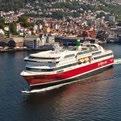
MV Bergensfjord

MV Stavangerfjord

HSC Fjord FSTR

MV Oslofjord
BERGEN–STAVANGER
STAVANGER–HIRTSHALS
HIRTSHALS–LANGESUND
KRISTIANSAND–HIRTSHALS
SANDEFJORD–STRØMSTAD
Hirtshals



The year 2023 marked a period of strategic decisions aimed at enhancing both our physical and digital customer journeys.
AS PART of these initiatives, our Marketing department was relocated from Sandefjord to Bergen, consolidating key commercial departments alongside our IT division to foster synergies and elevate digital communication strategies. Similarly, our Retail department transitioned from Sandefjord to Hirtshals, aligning with procurement and Onboard Sales and Services to streamline operations, bolster customer focus, and enhance product offerings.
Despite a period of 4 to 5-month out of operation, our LNG cruise ferries, MV Bergensfjord and MV Stavangerfjord, resumed full operations by mid-June, culminating in a positive conclusion to the 2023 high season. Particularly noteworthy was the exceptional commercial performance of our high-speed craft ferry, HSC Fjord FSTR, in company with the introduction of cruise ferries along our South corridor between Kristiansand and Hirtshals. Our intensified focus on this corridor was warmly received by customers, providing them with expanded options through Fjord Line, including 4 daily departures and the choice between the fastest ferry crossing with HSC Fjord FSTR or the most comfortable journey with enhanced amenities onboard our LNG cruise ferries.
CUSTOMER DRIVEN APPROACH TO ENHANCED CUSTOMER EXPERIENCES
As a part of our continuous efforts to improve our customer journeys, and based on the insight we achieved through a comprehensive strategic approach during 2022, resulting in a deeper understanding of our guest’s needs, motives and experiences when travelling with us, several investments to improve the customer experiences were carried out through 2023. During the engine conversion dock period, both MV Stavangerfjord and MV Bergensfjord were upgraded with a brand-new Fjord Lounge, and a new Kids Play area on deck 7, and an upgraded outdoor service and entertainment area on deck 10. In the Fjord Lounge on deck 7 our passengers can book a calm and guaranteed seat with access to a light snack and warm and cold drinks. Deck 10 got an upgraded outdoor lounge in
connection with our popular Sky Bar. With comfortable lounge furniture, heating and an outdoor stage, Deck 10 has become an even more popular bar and entertainment area on board with concerts and food service.
The dogs' resting area was also upgraded and enlarged during the dock period. The improved dog’s resting area in combination with an increased number of cabins suitable for guests travelling with dogs, has strengthen our customer offering for a continuously growing important customer segment which appreciate a comfortable journey also for their beloved pets.
IMPROVED CUSTOMER JOURNEY
– NEW TECHNOLOGIES AND FURTHER DIGITALIZATION
Technology and digitalization are vital enablers for better customer experiences and improving and simplifying our business operations. Fjord Line continues the comprehensive digitalization journey to harness technology's power and drive growth, efficiency, and customer satisfaction. Our digitalization initiatives encompass a wide range of projects, each designed to address specific challenges and opportunities in our industry. These projects are built upon a foundation of robust digital infrastructure, which includes cloud-based solutions, data analytics, and cybersecurity measures to ensure seamless and secure integration of our systems.
As we continue to make strides in our digitalization journey, we remain focused on enhancing the value we deliver to our customers and partners. By leveraging the potential of digital technologies, we aim to create more engaging experiences, improve our products and services, and streamline our internal processes for greater efficiency.
Based on the success with introducing the self-ordering service concept Onboard HSC Fjord FSTR in 2022, further development has been made to expand the concept with more self-ordering kiosks to improve efficiency and to include all food and beverage outlets for a better guest experience.


Several investments to improve the customer experiences were carried out through 2023.

During 2023, we strengthened our customer support focusing on our guests' expectations throughout all aspects.
During 2023, we strengthened our customer support focusing on our guests' expectations throughout all aspects. Further improvement of our chat functionality, including our chatbot, and investing in a new and stronger ticket system for managing customer enquiries and to monitor our performance, which again has secured an improved inquiry response time and hence our customer satisfaction.
Our digitalization journey has been significantly improved by seamlessly integrating technology into our physical customer experience. We've introduced automated boarding gates and selfservice check-in kiosks, which have significantly improved and enhanced the customer’s journey throughout our facilities. Automated boarding gates have transformed the boarding process, ensuring a smooth and efficient experience for our guests. These gates instantly verify passengers' identities and boarding passes, expediting boarding while minimizing the risk of errors and bolstering security measures.
Our self-service check-in kiosks have made the check-in process much more efficient. They empower passengers to check in, print boarding passes, and verify ID documents independently, reducing wait times and boosting efficiency at our facilities. The intuitive interface of our check-in kiosks makes navigation effortless for customers, with multiple language options ensuring accessibility for our diverse clientele. Additionally, the deployment of these kiosks allows our staff to concentrate on providing personalized assistance to those needing special attention or support.
By continuously updating and improving our automated boarding gates and self-service check-in kiosks, we have successfully utilized digitalization to improve the physical customer journey, creating a more efficient, secure, and enjoyable experience for our guests.
A crucial part of our commitment to customer satisfaction and digital advancement involves the continuous refinement of our booking solution, aimed at delivering a more streamlined and user-centric experience. Our efforts have notably reduced booking times, with ongoing enhancements to the intuitive interface and the introduction of new products tailored to individual customer needs. Complemented by a fresh colour palette and enhanced web layout, our revamped booking interface offers a more intuitive and efficient solution, facilitating smoother navigation and booking processes.
Recognizing the significance of seamless cross-device functionality, our new solution is fully optimized for desktops, tablets, and mobile devices. This ensures customers can


effortlessly access and book our services from any platform they prefer. Moreover, the updated booking system simplifies the payment process, providing customers with a diverse range of secure and convenient payment methods.
In line with our dedication to continuous innovation and elevating the travel booking journey, we are advancing our new self-service platform tailored explicitly for travel agents. This pioneering solution empowers agents to seamlessly arrange trips for their clients, streamlining the process and enabling them to deliver a higher standard of service.
Central to our self-service platform is a dedicated agent portal, providing travel agents with effortless real-time access to an extensive array of booking tools and resources. The portal gives a user-friendly interface and intuitive navigation, simplifying the search and booking process for agents across all our offerings. Building upon this, a significant enhancement was implemented in 2023, providing our agents with additional self-service capabilities for managing their bookings. This evolution affords our agents greater flexibility and equips them with enhanced tools to improve their services for their clients.
We are continuously improving and expanding our self-service solutions. The «My Page» feature provides customers with a centralized platform to manage all aspects of their journeys, from initial booking to itinerary adjustments, as well as access to boarding passes and travel documents. Furthermore, customers can effortlessly manage their Fjord Club loyalty club membership through this platform.
627.000 PER 31.12.2023
The seamless integration of trip management and loyalty club functionalities presents significant commercial opportunities. The "My Page" feature is prepared for the introduction of our new Fjord Club content and functionalities, promising a more cohesive and personalized experience for our customers. This ensures they have instant access to all necessary information, resources, and a comprehensive overview right at their fingertips.
In our ongoing efforts to enhance service also for our freight customers, we introduced Digitoll in 2023. Digitoll represents a concept that facilitates digital submission of advance notification, declaration, and disclosure, significantly streamlining the customs process for our clients.
At Fjord Line, we're dedicated to providing top-notch experiences for our customers while also growing our business. That's why we've made a big move toward using marketing automation. Our use of marketing automation is ever evolving, and new steps have been taken to harness its many possibilities. Not only in identifying new potential customers but in reengaging and in upselling, through utilizing customer data and insight. We're also using data-driven insights to understand our customers better. In 2023 we have focused on improving the information sent out to our guests before travelling. This has been done to improve customer satisfaction, timely information about the upcoming journey, and upselling of products like meals on board.
The techniques, strategies and technology of marketing automation have been key in creating a tailored multichannel communication platform that reaches and engages our customers. We are focusing on developing the field of marketing automation in Fjord Line exponentially going forward. By doing this, we're able to engage with our customers more effectively and create marketing campaigns that are personalized just for them, depending on what they have ordered and who they are. This approach helps us make sure our marketing is always relevant and timely, which leads to more satisfied customers and higher conversion rates.
At Fjord Line, we want to show our appreciation to the guests who travel with us regularly. That's why we created the Fjord Club. Since its inception, our membership has soared to approximately 627,000 strong by 2023. The Fjord Club members are our most loyal guests, and we're always working on improving our offers and how we communicate with them.
We make sure to give our Fjord Club members special treatment. They get personalized messages with offers that are tailored just for them. And we're committed to making the Fjord Club program even better in 2024, so our loyal guests can enjoy even more perks and benefits. There is an ongoing initiative regarding the strategy for the loyalty program in its entirety: this will revitalize our offering to loyal customers.


The Fjord Club members are our most loyal guests, and we're always working on improving our offers and how we communicate with them.
OFFERING EFFICIENT, flexible, and high-quality tailored sea transport services - to support our customers in growing their businesses – is an important part of Fjord Line’s business. We transport all types of freight daily - from lorries, semi-trailers, special loads as long/wide/heavy, and trailers to imported cars etc. Fjord Line offers several convenient sailing schedules to meet our customers’ needs. Our freight service is also fully customizable to meet our customers’ specific requirements.
Central to our operations is a dedication to sustainability and minimizing our environmental impact. Fjord Line prioritizes contributing to a more sustainable future for global sea logistics. Our vessels are designed with environmental friendliness in mind and are equipped with cutting-edge technology to reduce our carbon footprint.
Despite facing challenges in 2023, such as temporarily halting LNG ferry operations for engine conversions, Fjord Line's freight business continued to excel. We focused on informing our clients of our return to operation and worked diligently to regain historical volumes. Throughout the year, we witnessed an uptick in demand and unwavering loyalty from our customers.
A strategic decision in 2023 to enhance our presence on the freight corridor between Kristiansand and Hirtshals by increasing freight capacity with LNG ferries proved fruitful. The introduction of an evening departure from Hirtshals to Kristiansand from October to May was well-received by our customers, further improving freight capacity. In emphasizing our role in society, 2023 underscored Fjord Line's significance in connecting coastalcommunities and facilitating trade between Norway and Continental Europe. We take pride in our ongoing contribution to fostering connectivity and facilitating commerce across borders.

Fjord Line prioritizes contributing to a more sustainable future for global sea logistics.
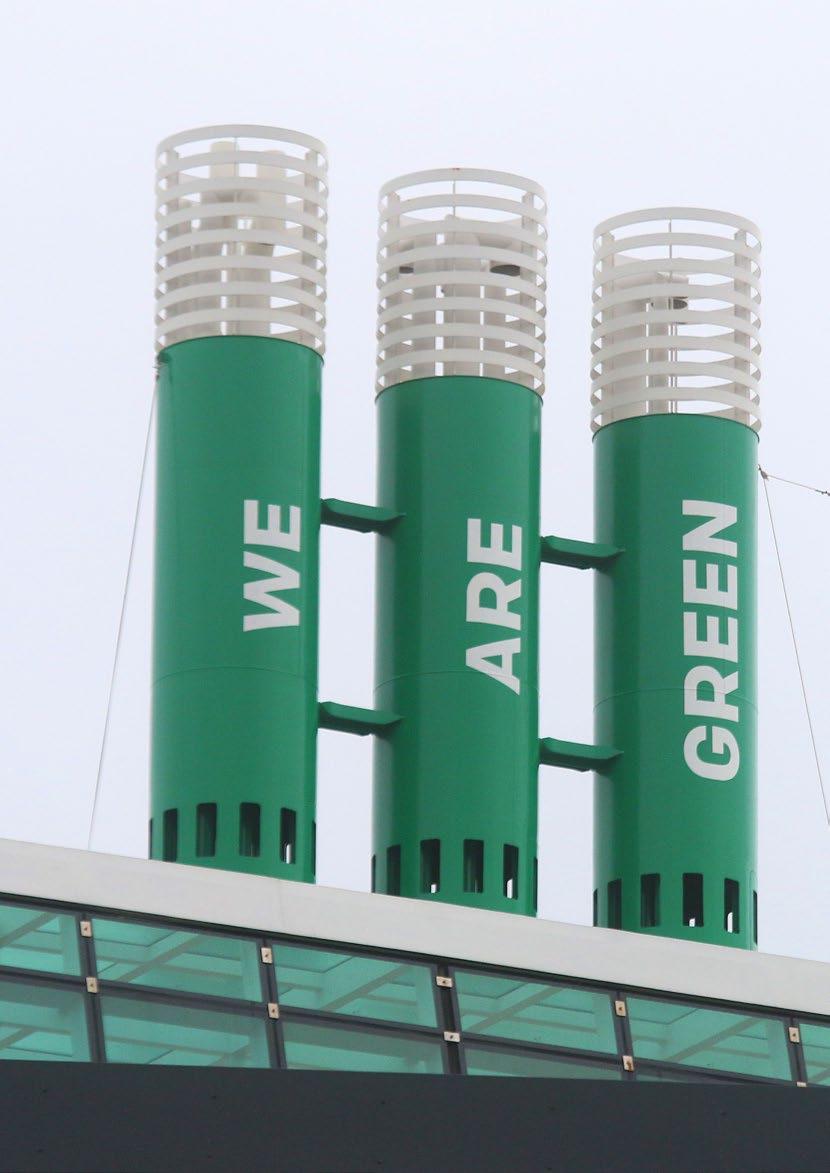
Fjord Line’s vision to become Scandinavia’s best, most loved and profitable ferry company includes a strong commitment towards sustainability leadership including sustainable and responsible business operations.
THIS INCLUDES strategic focus and strong commitment towards:
• Environmental leadership - we are committed to take leadership in decarbonization at sea/maritime travel, protecting the ocean, and reduce waste.
• Social responsibility and a safe, engaging, and inspiring working environment - we act as a responsible employer and ensure that our people thrive at work.
• Responsible business practices and good corporate citizenship - we operate based on responsible high business integrity and practices.
We are strongly committed to maintain stewardship across all ESG dimensions and aim to be a responsible contributor to society and recognize that our impact extends beyond our own operations. One of the most important sustainability challenges affecting maritime transport today is decarbonization. With the investment in our Liquified Natural Gas (LNG) ships, Stavangerfjord and Bergensfjord in 2013/14, Fjord Line were pioneers in carbon-efficient marine transport. Since 2008 we have improved our carbon efficiency by almost 50% and established a clear environmental leadership within our peer group. We do not rest on our laurels, however, and will continue to improve to further strengthen our sustainability leadership going forward. Our goal is to increase our energy efficiency by an additional 20% from 2019 to 2030.
Environmental benefits by choosing to travel with Fjord Line instead of by road.

Our goal is to increase our energy efficiency by an additional 20% from 2019 to 2030.
We focus on what matters the most. We engage in stakeholder dialogue to evaluate which topics are most important to our stakeholders. We also identify topics which can have a material economic, environmental, or societal impact. Fjord Line’s primary stakeholders include customers, employees, owners and lenders.
Human rights and labor rights
Material and waste management
Health, safety and wellbeing
Learning and development
Business ethics and anti-corruption
Air quality
Diversity
Pollution to sea
Responsible procurement
Climate change
Global warming remains one of humanity's biggest challenges to sustainable development. Shipping contributes to ca. 3% of global GHG emissions. The global shipping regulator IMO has defined a GHG strategy to cut GHG emissions by 50% from 2008 to 2050. EU is pursuing a similar path to cut CO2 emissions in EU by 55% by 2030.
pollution to sea from shipping operations include ballast water, black and grey water, waste, plastics, toxins and risk for oil spills. While several of these pollution sources are strictly controlled in maritime regulation, Fjord Line is committed to preventing and reducing pollution as much as possible
Materials use in our operations include both goods for sale to our guests (e.g. food and tax free goods) and hardware for use in our operations (e.g. from ship investment and maintenance). Impact from materials use can be improved by reducing overall materials consumption, increasing share
Human rights and labor rights are gaining increasing stakeholder attention. Fjord Line exclusively employ people in the Nordics, subject to strong regulation and reporting obligations. Hence, our compliance with such regulation ensures a good baseline performance on human and labor rights. However, we indirectly employ people through our suppliers and we have the power to influence how rights are upheld among our suppliers in other parts of the world.
with various
(gender,
A safe and healthy environment at sea and on shore for our employees and customers is a fundamental requirement for a sustainable business. We are committed to maintaining high health,
and to prevent
Employee training and opportunities for personal and career development are important to maintain high employee motivation, to contribute to the development of maritime competence and to enable good customer experiences. Training is also an integral part in ensuring safe, efficient and sustainable operations. Business ethics and
Business ethics include management of risks related to anti-competitive practices, accounting, taxation, bribery, corruption, money laundering, IP rights and sanctions.
We recognize that our responsibility extends to our suppliers and that we can influence sustainable operations through our procurement. This includes ensuring our suppliers are familiar with our standards and that adherence to those standards are made effective through our procurement operations.
Shipping is the most environmentally friendly mode of transport over long distances. Nevertheless, shipping accounts for almost 3% of global greenhouse gas (GHG) emissions. Regulatory bodies, such as the International Maritime Organization (IMO) and the EU, recognize the need for decarbonization of shipping to support the Paris agreement.
AT FJORD LINE we are committed to do our part in curbing global temperature increase to 1.5 degrees and to be a partner to society.
Our main goal is to improve our carbon efficiency, defined as average efficiency ratio (AER)*, by 56% in 2030 compared to 2008 levels. This is more ambitious than IMO’s target of 40% in the same period. We have already made significant investments into technology and operations to improve our energy efficiency since 2019. Going forward, our goal is to improve AER with an additional 20% from 2019 to 2030.
Our fleet has a class-leading sustainability profile. MV Bergensfjord and MV Stavangerfjord run on LNG which produces up to 23% lower carbon emissions compared to diesel engines. Nitrogen oxide emissions (NOx) from these vessels are as much as 91% lower and emissions from Sulphur (SOx) and soot (PM) are virtually eliminated. In 2015 this led to the sister ships receiving the highest Environmental Ship Index (ESI) score in 2015, in competition with approximately 3,200 other ships. Electricity for use onboard is produced by converting waste heat from the exhaust gas into steam-generated energy. Thus, MV Bergensfjord and MV Stavangerfjord cover their electricity needs for cabins and public spaces.
HSC Fjord FSTR and MV Oslofjord run on Marine Gas Oil (MGO) which emits considerably less Sulphur emissions than traditional marine fuels such as Heavy Fuel Oil (HFO). The catamaran HSC Fjord FSTR, is a new-build to replace HSC Fjord Cat and operates with an estimated 32% less GHG emissions per passenger compared to its predecessor. MV Oslofjord relies on land-based
power when in harbor in Sandefjord. MV Bergensfjord and MV Stavangerfjord are not applicable for land-based power as they are in continuous operation. HSC Fjord FSTR connects to landbased power in Kristiansand.
In 2019, we started implementing AI-assisted tools onboard to provide the captains and officers with decision support regarding the most optimal energy efficiency voyage operation of the vessel, this system has shown a 5% fuel reduction and is now rolled out across all of Fjord Lines fleet.
The energy crisis, caused by the Russian invasion of Ukraine in 2022, led to extraordinary volatility and significant price increases in LNG well above financial sustainable levels – and far higher than for traditional and less sustainable energy sources at sea. We decided to convert our single LNG fueled vessels MV Stavangerfjord and MV Bergensfjord enabling the two LNG-ships to switch between LNG and MGO (Marine Gas Oil), which will ensure a financially sustainable operation until the LNG-price level is normalized. We were saddened by the need for the conversion towards use of MGO, despite Marine Gas Oil having significantly reduced emissions of sulphur than traditional fuel such as HFO (Heavy Fuel Oil). The conversion is however critical to maintain our customer offering, secure workplaces, and to secure the continued development of Fjord Line.
CO2 EFFICIENCY BY 20% FROM 2019 TO 2030
Going forward, we will continue to improve operating and technical aspects to our fleet and operations, to continue our positive momentum of increasing energy efficiency, and further decarbonization.

MV Bergensfjord and MV Stavangerfjord run on LNG which produces up to 23% lower carbon emissions compared to diesel engines.
To meet our target of a 56% reduction in GHG emissions by 2030 compared to 2008 levels we will need even greener fuels than LNG. Fjord Line is now evaluating next generation fuels with zero or limited CO2 footprint.
Relying on the right type of fuel is of course the most important factor in drastically reducing emissions of both GHGs and air pollutants. However, we must also ensure energy efficient operations through good technical and operational solutions.
In 2020, we invested in a new antifouling system on MV Stavangerfjord which has produced an additional 5% energy savings. We will continue to roll-out low-friction, environmentally friendly antifouling on our fleet, to reduce fuel consumption.
We are continuously trimming operational improvement for check-in, bunkering, loading and unloading of vessels, to reduce turnaround times. Time saved in port can be used to reduce sailing speed and save fuel. We are also evaluating technical improvement, such as new propeller and rudder designs, to reduce drag and improve efficiency.
Our current fleet is modern with an average age of 14 years. Our oldest vessel MS Oslofjord was built in 1993. For new builds, we will strive to design vessels based on renewable and carbon neutral fuels. Such fuels could include e.g. ammonia, e-methanol, hydrogen, or battery. We acknowledge that such technologies and infrastructure are not readily available today and there is considerable development of both technology and infrastructure remaining. However, we anticipate they will be available by 2030. We will partner with ship builders, engine manufacturers and
classification societies to identify our preferred path to future fleet carbon neutrality.
Protecting the oceans is a primary concern for Fjord Line. All wastewater and sewage are handled according to the most rigorous standards. Fjord Line is complying with the International Convention for the Prevention of Pollution from Ships (MARPOL). With MV Bergensfjord and MV Stavangerfjord we have gone beyond the MARPOL convention and make sure that all wastewater and sewage goes through an approved treatment system before being released. With MV Oslofjord all wastewater and sewage are collected and handled on shore.
We have a continuous focus on reducing the food waste in our onboard restaurants. For example, we have brought down the volume of uneaten food by encouraging our travelers to only help themselves with what they can eat in a nice and friendly manner. Food waste is being reduced in the galleys as well. Other waste, such as single use plastics and packaging is also being scrutinized.
We collect, sort, separate and take all solid waste to shore for adequate handling after arrival. In general, we are recycling approximately 25-30% of all our solid waste. Solid waste includes everything from steel to food to packaging and cardboard.
FJORD LINE contributes towards Sustainable Development Goal number 7, “Affordable and Clean Energy” and number 13” Climate action” by using cleaner fuels, investing in new types of fuel, and reducing energy consumption in our operations. Moving towards a world that relies mostly on renewable energy is essential to protect human wellbeing and ensure sustainable lives for all. At Fjord Line we are proud to say we are pioneers in this field.
FJORD LINE contributes towards Sustainable Development Goal number 3, “Good Health and WellBeing”, by reducing the amount of air pollutants from our ships. In 2020, an additional and immediate focus became to help stop the spread of the COVID-19 disease. Good health is fundamental to good lives: our employees, customers, and humans in general. It is in our best interest to do our part to contribute towards the wellbeing for all.
FJORD LINE contributes towards Sustainable Development Goal number 14, “Life Below Water”, by reducing emissions to the ocean, reducing the amount of solid waste we produce, recycle what we can and process what remains on land. Debris and pollutants at and under the ocean’s surface are a to life in the sea.
FJORD LINE contributes towards Sustainable Development Goal number 12, «Responsible consumption and production».
THE FOLLOWING FORMULA IS USED TO CALCULATE AER:
Where:
Ci is the carbon emissions for voyage i, using the fuel consumption and carbon factor of each type of fuel used. gt is the gross tonne of the vessel. Di is the distance travelled on voyage i.
The IMO is a specialized agency of the United Nations that is responsible for measures to improve the safety and security of international shipping and to prevent marine pollution from ships. The IMO sets standards for the safety and security of international shipping. It oversees every aspect of worldwide shipping regulations, including legal issues and shipping

In their GHG strategy, the IMO has formulated a goal to cut annual absolute GHG emissions from international shipping by at least half from 2008 to 2050. The strategy requires a reduction in carbon intensity emissions (i.e. CO2 emissions per transport work) by an average of 40% by 2030 and 70% by 2050, both compared to the 2008 baseline.
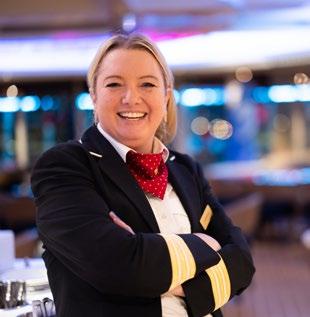

We are very fortunate to have such dedicated people and leadership in Fjord Line demonstrating strong courage, remarkable efforts, and always with an eye for developing and delivering the best customer experiences.
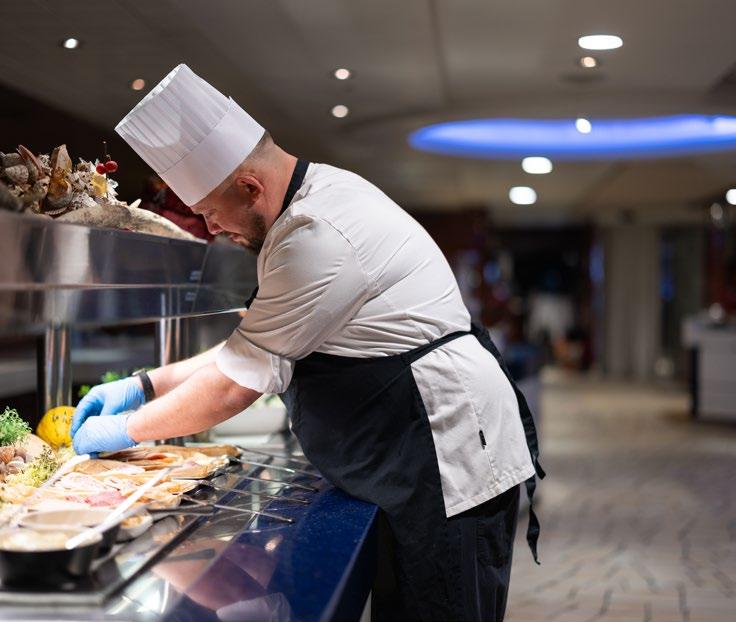
We have a continuous focus on reducing the food waste in our onboard restaurants.
At Fjord Line, we hold a deep commitment to our social responsibility and aim to be a responsible contributor to society. Fjord Line’s ESG-strategy is closely aligned with our mission, vision, and core values, serving as an essential component and prerequisite for our success.
OUR PEOPLE serve as the cornerstone of our success, and Fjord Line’s ability to attract, retain, and develop talented individuals at all levels is crucial in fulfilling our mission and vision.
Fjord Line is based on sound business values. Everything we do is anchored around vigour, responsibility, respect, and commitment towards customers, colleagues, and all other stakeholders including society. Our values serve as shared principles that unite the organization, guiding our actions, decisions, and interactions, thereby fostering a cohesive and collaborative work culture. We focus on mutual respect and helpfulness across job functions, which caters for a great work environment, but also extends to the hospitality which meets our customers.
Diversity is high on our agenda, which means that we tolerate nothing less than equal space for everyone no matter their gender, ethnicity, or age. Specifically related to age we are proud of the fact that we have several four generation members working with us side-by-side. To us you can only be respectful when valuing competences and contributions at any age – and across all functions.
Our commitment to responsible business practices is also strongly linked to our mission, vision, and values and how the company promotes sustainable, responsible, and ethical business operations and fostering a more equal society.
We are strongly committed to act as a responsible employer acknowledging the importance and value of our people. This includes ensuring a safe, purposeful, inclusive, and inspiring working environment and that our people thrive personally and professionally at work.
Our focus to act and be valued as a responsible and attractive employer is anchored around creating a strong company culture securing the wellbeing, motivation, and development of our people and where our people feel valued, engaged, and trusted. This also includes securing our people are treated with respect
and provided with the resources and opportunities to thrive and consequently feel confident to contribute and act. We are confident that a strong corporate culture embracing diversity and inclusion fosters greater value for all stakeholders.
The year 2023 has been highly affected by major strategic initiatives within the company such as; rebuilding LNG-ships from single-fuel to dual-fuel engines, route discontinuations, and introduced new customer offerings on our south corridor between Hirtshals and Kristiansand including a new domestic route between Kristiansand and Stavanger/Bergen in the beginning of 2024.
During 2023 we discontinued the operations on the route between Sandefjord in Norway and Strömstad in Sweden, and our operation in the port of Langesund. The discontinuations led to organizational changes as we closed all operations with MV Oslofjord and the Sandefjord, Strömstad and Langesund offices, moving towards a leaner organizational set-up for our entire business. This unfortunately led to the departure of many of our valued colleagues. There has been a strong focus on securing a respectful and responsible process in relation to those of our colleagues, who would no longer be part of Fjord Line as for those who otherwise were affected by the organizational changes and in the way we work.
The engine conversions in the first part of the year resulted in two of our ships being out of operation for several months and consequently many of our seagoing employees were out of operation during this period. Instead of dismissals, we chose to invest in competence development by implementing a training project funded in part by the Adult Training Program (VEU). In collaboration with the local educational institutions in and around Hirtshals, we completed a total of 2920 competence development days, including courses in language training, hotel operation, cooking, health, conflict management, cleaning, IT, safety, project management, etc.

Our people serve as the cornerstone of our success.


Our people have shown strong loyalty, commitment, and “going the extra mile” as we jointly navigated through new and very challenging times. We are very fortunate to have such dedicated people and leadership in Fjord Line demonstrating strong courage, remarkable efforts, and always with an eye for developing and delivering the best customer experiences.
Fjord Line is continuously working to ensure an organization representing diversity and inclusion and we are strongly committed to provide equal rights and equal opportunities for all people at Fjord Line. We respect human rights, and all employees should feel valued, respected, and treated with dignity. We aim to avoid any form of discrimination based on gender, age, ethnicity etc., and has zero-tolerance for harassment of any kind.
Measured in average head counts in 2023, the Group had 772 employees, whereof 281 were shore-based and 491 were seagoing employees and covering 478 (62%) males and 294 (38%) females employees. This is at the same level as in 2022. Group Management includes a total of six directors, whereof one (17%) is females and six (83%) are males.
Fjord Line operates within the maritime industry, which traditionally is a male dominated industry where female job candidates are generally low, especially for jobs at Sea, but we do our best to motivate female applicants for all jobs in our organization. In 2023 our people at Sea were 68% males and 32% females. Our target for 2024 is 65% males and 35% females. For jobs at Shore, we have an almost equal balance with 51% males and 49% females. At Management level at Sea, we have a gender gap in 2023 reflecting the maritime industry in general with 91% males and 9% females. The target for 2024 is 10% females and 90% males in Management positions at Sea. On Shore the representation is at our target for 2024 at 50% males and 50% females in leadership roles.
Fjord Line is strongly committed to the principle of equal opportunities, development including promotion and equal compensation for equal work. At Sea, everyone is paid according to collective agreements and therefore we have no gender pay gap. At Shore 46% of all employees follow a collective agreement reflecting equal pay regardless of gender.
The remaining 54% of our staff on Shore are employed on individual contracts and in functions where we typically only
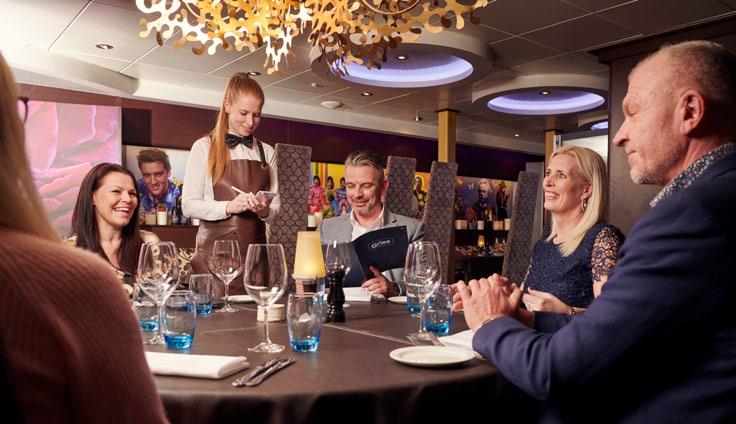
employ one employee per function, which makes it difficult to identify any specific gender pay gap. However, to ensure that no discrimination occurs regarding compensations on individual contracts, we will continue to conduct internal analyzes and benchmarking against comparable data from the industry and external salary surveys to ensure fair and equal compensation terms for all our people.
We work hard to ensure that our people processes are highly professional. This also includes ensuring that promotions are fairly performed based on e.g., skills, education, and experiences and supporting an organization representing diversity, inclusion, and equal opportunities. In 2023, we promoted 11 internal candidates, covering 5 female and 6 male candidates. We continued the strong focus on competence development of our people to support their further development, motivation, and engagement, and which we are convinced will translate to even better customer experiences going forward.
Equality work within recruitment is also ongoing. Among other things, when applying for a job with us, candidates no longer have to state gender or age, only education and experience are mandatory. In 2023, we have created recruitment campaigns that
show that everyone, regardless of gender and age, can qualify for a job in the maritime industry. Furthermore, all competence development, promotions and training has continued to support equal opportunities for all employees irrespective of gender. And we additionally developed a new interview guide in 2023 to further support the interviewer to conduct recruitment processes biasfree.
The safety, health, and wellbeing of our people is our number one priority and throughout the year we have maintained high focus on creating a safe, health and engaging working environment where our people thrive also during very challenging times. Our sea- and land-based employees regularly conduct safety and emergency education & drills according to industry standards. Fjord Line also continue to run a “No blame open mind safety culture” program with very low thresholds for registration of accidents and we continuously work to reduce the level of work accidents through training and ongoing evaluation of our policies and performance.
We monitor sick leave to prevent and reduce absence due to illness. In 2023, our overall sick leave was 3,5% with 4,3% at Sea and 2,3% at Shore. This equals a minor increase of 0.2 %-points
compared to 2022 (3,3%). Overall absence rates are slightly above both our target of < 4% for seagoing employees and the target of shore employees of < 2%. We will continue our efforts to reach our targets going forward.
To support focus on health and wellbeing we have made an update on our absence guidelines to ensure that we have solid processes to maintain a low sickness absence going forward.
At Fjord Line, we respect human rights, and all employees should feel valued, respected, and treated with dignity. We aim to avoid any form of discrimination based on gender, age, ethnicity etc. and has zero-tolerance for harassment of any kind. Despite having a zero-tolerance for harassment of any kind, we did see a few cases in 2023. These were acted on promptly and followed-up by management, clearly emphasizing the zero-tolerance.
We have clearly articulated responsible employer standards & polices for working hours, overtime working, and vacations etc. Fjord Line has an implemented policy regarding the possibility of remote work for our Administrative Shore Staff. The policy follows the Norwegian legislation as per 18. March 2022.
Our business is highly influenced by peak and off-peak seasons and consequently our staff are employed on different contracts covering full-time, part-time, or temporary employment. The level of temporary staff at Sea is 64% male and 36% female and at Shore the corresponding numbers are 52% males and 48% females. Part-time staff at Shore is 47% males and 53% females.
Maternity and paternity leave for staff at Sea shows in average 10 weeks for males and 23 weeks for females. At Shore the average totals 5 weeks for males and 15 weeks for females.
Employee engagement, satisfaction, and retention is crucial as we strive to be an attractive responsible employer of choice with a strong company culture securing the wellbeing, motivation, and development of our people and also in securing Fjord Line’s longterm, sustainable business development.
Hvordan melde inn sykdom?
Alle ansatte Du ringer direkte til lederen din og sykemelder deg.
Ring til: Telefonnr.: Andre avtaler:
In 2023, a year highly affected by major strategic changes within the company, Fjord Line is proud to have an employee turnover rate of 7,9%, which is remarkably low compared to our industry average and Fjord Line maintains a strong employer brand position. Most people are recruited locally in Western and Southwestern Norway and Northern Denmark, which helps contribute to the well-being and development of the local societies we are part of.
Every year, Fjord Line experience a strong demand for local educational institutions to experience a “school day at sea” including practice learning about the many different possible positions a maritime work life provides. Based upon feedback from institutions and participants, we are very optimistic that our recruitment success will continue also in the years to come as we continue to invest in promoting our industry and company.
Our employee engagement and satisfaction survey (MTU) was conducted in 2022. In 2022, we implemented a new reporting tool making it possible for us to create ongoing pulse measurements and follow-ups several times a year. The primary focus in 2022 was on first getting familiar with the new tool. The overall result, however, showed good scores on employee engagement and satisfaction despite very challenges times for all our people during the years of turbulent times. The eNPS score was 12 and Engagement Score was 72. Since the tool is new, we have no comparable and benchmarking data from previous years.
Due to the many strategic changes affecting a significant number of our employees and entailing a focused effort from our HR department, we decided that the next survey would be conducted in April and October 2024 with an ambitious target for our Engagement Score of ≥ 74 and eNPS of ≥ 18.
At Fjord Line, we promote a safe speak-up culture with a zerotolerance approach towards breach of our Code of Conduct to secure we operate based on responsible high business integrity standards & practices, ethics and moral. Our anonymous whistleblower system is available to all our people and hosted through an external service provider. Reports concerning various types of unethical behavior are reported, investigated, and handled and these counts only two cases in 2023. Hvordan melde inn sykdom?
Ring til: Telefonnr.: Andre avtaler: Offisiell sykefraværssamtale sykemeldt, invitere deg for å sykefraværssamtale når har vart tre uker. en konkret dialog situasjon, skal dere undersøke muligheten kommer helt eller delvis jobben. holde deg i arbeid.
Alle ansatte Du ringer direkte til lederen din og sykemelder deg.
Sjøansatt: Blir du syk natten før utmønstring, må du straks gi beskjed til resepsjonen. Senere ringer du også til lederen din. Blir du syk om bord, kontakter du arbeidslederen din.
Landansatt: Dialogen om sykefraværet ditt foregår mellom deg og lederen din.
Sjøansatt:
utmønstring, må du straks gi beskjed til resepsjonen. Senere ringer du også til lederen din. Blir du syk om bord, kontakter du arbeidslederen din.

OM SYKEFRAVÆR

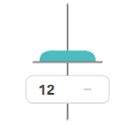
281 Shore based / 491 Sea going staff
FJORD LINE contributes towards Sustainable Development Goal number 5, “Gender Equality”, by ensuring equal pay for equal work, work actively against any form of discrimination on the basis of gender, work to balance the workforce with regards to gender, encourage women to take leadership positions and include provisions against harassment in our code of conduct.
At Fjord Line, we are committed to operate on responsible business practices & good corporate citizenship governed by our Code of Conduct to ensure we conduct business in a responsible, sustainable, safe, ethical, and transparent way.
THE WAY WE CONDUCT business is based on high business integrity standards linked to Fjord Line's overall vision and embedded in our overall corporate governance, including our corporate values, policies, and procedures. The Board of Directors has the ultimate responsibility for sustainability and monitors our performance and development on key ESG-measures regularly. Group management is responsible for carrying our operations and development in line with the standards and goals set by the Board of Directors.
A separate compliance function is responsible for follow up of compliance and ethics. To ensure independence, the Compliance function reports to the CFO with double line reporting directly to Board of Directors. Fjord Line has several mechanisms in place to manage and monitor compliance with external and internal policies and standards.
The company has a groupwide Safety Management System (SMS) in place. The system is developed in accordance with the international “ISM-code”, to ensure safe management and operation of ships and for pollution prevention. In addition, Fjord Line complies with a number of international regulations aimed at ensuring safe and secure maritime passenger transport. We have in 2022 decided to go forward developing a new group wide management system including all our operation both onboard and onshore.
Our code of conduct is founded on human rights as well as the value of diversity and inclusion. It sets out the standards defining how we operate every day and everywhere. The code of conduct governs our relationships with clients, suppliers, stakeholders and each other. It requires all employees to adhere to the highest levels of professional conduct and underpins the reputation and trust Fjord Line commands. Routines for reporting any breach of our codes of conduct are in place and available for all employees. Whistleblowers are protected through these routines to ensure that there are no hindrances or risks to filing a report.
Fjord Line utilizes a wide range of suppliers and business partners within our Supply Chain organization supporting all facets of our business both on-board and land-based operations. We recognize that our impact extends beyond our own company and that we can impact sustainability topics through our supplier selection and management. Our supplier code of conduct govern our relationship with our suppliers to ensure our suppliers operate with high business operational standards & practices based on strong commitment towards sustainability, high business ethical standards, and human rights. We are currently working on rolling out the supplier code of conduct to all major suppliers.
Ethical and sustainable construction and reuse of our vessels is of importance to us. When we ordered HSC Fjord FSTR we made sure that it was built according to the Hong Kong international convention for the safe and environmentally sound recycling of ships. This ensures that the ship will not pose any unnecessary risk to human health, safety and to the environment when it reaches end of life.
Fjord Line has working procedures to reduce the risk of corruption. Corruption is a risk especially related to large procurements. We reduce this risk through our procurement policy that calls for tender processes for large purchases and an approval process that ensures that all such purchases are evaluated objectively and by several people. The whistleblower function is open for reports on suspected corruption related to procurement or otherwise.
The Norwegian transparency act went into effect in Norway on the 1st of July 2022. The act aims to promote enterprises’ respect for fundamental human rights and decent working conditions in connection with the production of goods and the provision of services and ensure the general public access to information regarding how enterprises address adverse impacts on fundamental human rights and decent working conditions.

COMMUNICATE HOW IMPACTS ARE ADRESSED
TRACK IMPLEMENTATION AND RESULTS
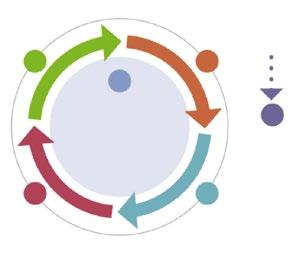
IDENTIFY & ASSESS ADVERSE IMPACTS IN OPERATIONS, SUPPLY CHAINS & BUSINESS RELATIONSHIPS
PROVIDE FOR OR COOPERATE IN REMEDIATION WHEN APPROPRIATE EMBED
BUSINESS CONDUCT INTRO POLICIES & MANAGEMENT SYSTEMS
OECD (2018) OECD Due Diligence Guidelines for Responsible Business Conduct
The purpose of the act is well aligned with our long-term focus at Fjord Line and part of our how we conduct business.
We have a formalized process for classification and risk assessment of our suppliers and business partners to address adverse impacts on fundamental human rights and decent working conditions. The due diligence process is carried out in accordance with the OECD guidelines for Multinational Enterprises in accordance with §4 in the Norwegian transparency act. The assessment evaluates both the direct relationships and the underlying supply chain. From the starting block our assessments are based on a desktop approach based on publicly available information as well as our direct knowledge based on our former relationships, and we are further developing the process to include questionnaires, interviews etc.
If the risk is assessed to be at an undesirable level, we assess how we can influence the risk level in a positive fashion, either through direct interaction, or by investigating other methods such as change of specifications or sourcing. The due diligence process and working with supporting measures is a continuous process to ensure that we properly address potential adverse impacts on fundamental human rights and decent working conditions. Furthermore, we will elaborate on our approach in the annual reports.
At Fjord Line, we care about protecting and respecting the data of all our stakeholders, based on the highest data ethics standards. The rapid development and use of technology in the world, as well as in our industry, leads to more data being shared between stakeholders, which demands high attention and dedication to follow strong data ethics standards, policies, and procedures, which we fully comply with.
The use of technology and digitalization helps Fjord Line to deliver better customer experiences and to improve and simplify our business operations. Digitalizing our services and business operations also helps us to build stronger, more efficient, and more standardized business foundations.
We keep focusing on innovation and are committed to ensure leadership in technology, digital innovation, and development, following the highest data ethics standards, including responsibility, sustainability, and transparency.
Fjord Line is committed to creating and maintaining secure and privacy-friendly services that customers can use without having to worry about having their integrity and personal sphere compromised.
We are committed to the principles inherent in the GDPR and particularly to the concepts of privacy by design, the right to be forgotten, consent and risk-based approach. In addition, we aim to ensure:
• Transparency with regard to the use of data.
• That any processing is lawful, fair, transparent and necessary for a specific purpose.
• That data is accurate, kept up to date and removed when no longer necessary
• That data is kept safely and securely
The privacy policies establish the baseline for all of Fjord Line's services and obligations and ensures the safeguarding of customer rights.
Fjord Line acknowledge the threat cyber-attacks or failure of internal systems and digital networks have on our ability to operate and protect the privacy of data. To mitigate consequences of such attacks and create a secure operating environment Fjord Line has developed a long-term security strategy aimed at securing Fjord Line’s business.
The foundation for this strategy is risk-based maturity improvement and continuous development of critical security capabilities and competencies throughout the organization. At the core of this work Fjord Line has established an Information Security Management System (ISMS) based on the NIST CSF Framework. Our ISMS system includes contingency plans, guidelines, and policies to support Fjord Line's operation both with identifying, protecting and recovering from critical events.
As a ferry operator digital security is considered as part of the company’s license to operate. Digital Security is a considered a shared responsibility for all of us in Fjord Line and the digital security initiatives therefore includes company wide training to prepare everyone for their responsibility.
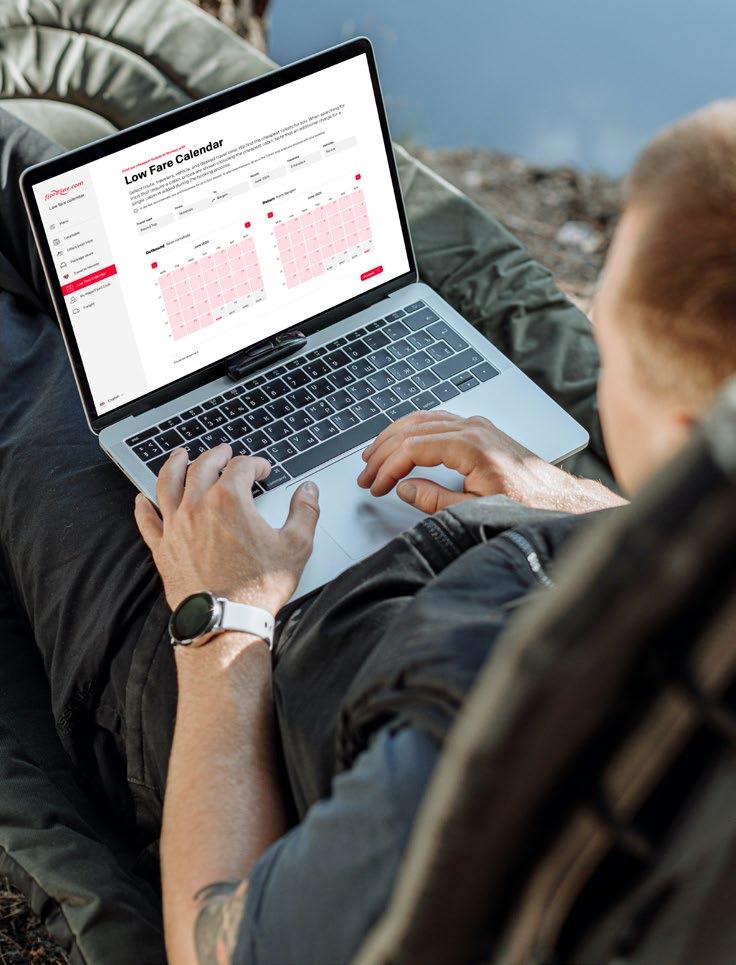
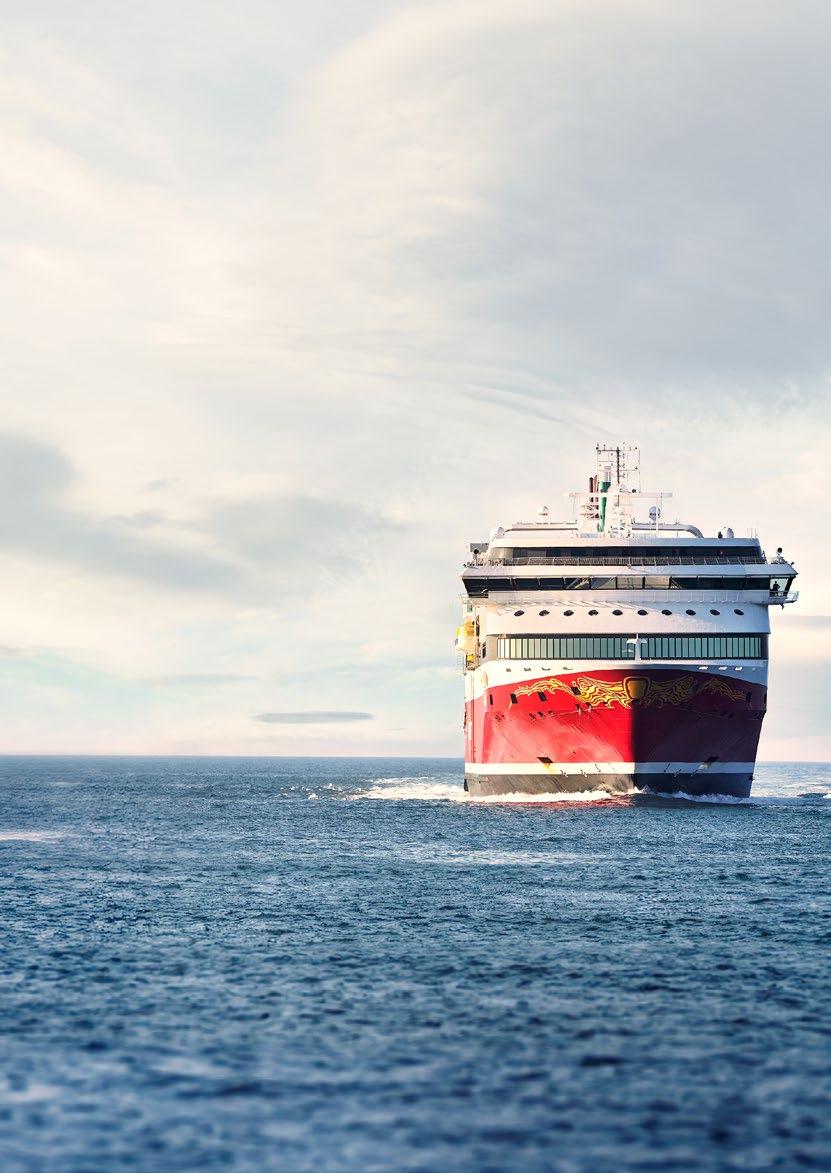
ACTIVITY
General
ENVIRONMENT
GHG emissions
SOCIAL
Air quality
Ecological impacts
Waste management
Number of passengers
Number of freight units
Total distance traveled by vessels
Gross emissions
GHG per Nm
GHG per transport work
NOX emissions
SOX emissions
Number of spills
Volume of spills
Solid waste % recycled
Employee health, safety and wellbeing
GOVERNANCE
Oversight and compliance
Lost time accidents >24 h (LTA) Sick-leave
Average number of full time employees
Diversity (gender distribution)
Number of ordinary board meetings
Number of port state control deficiencies
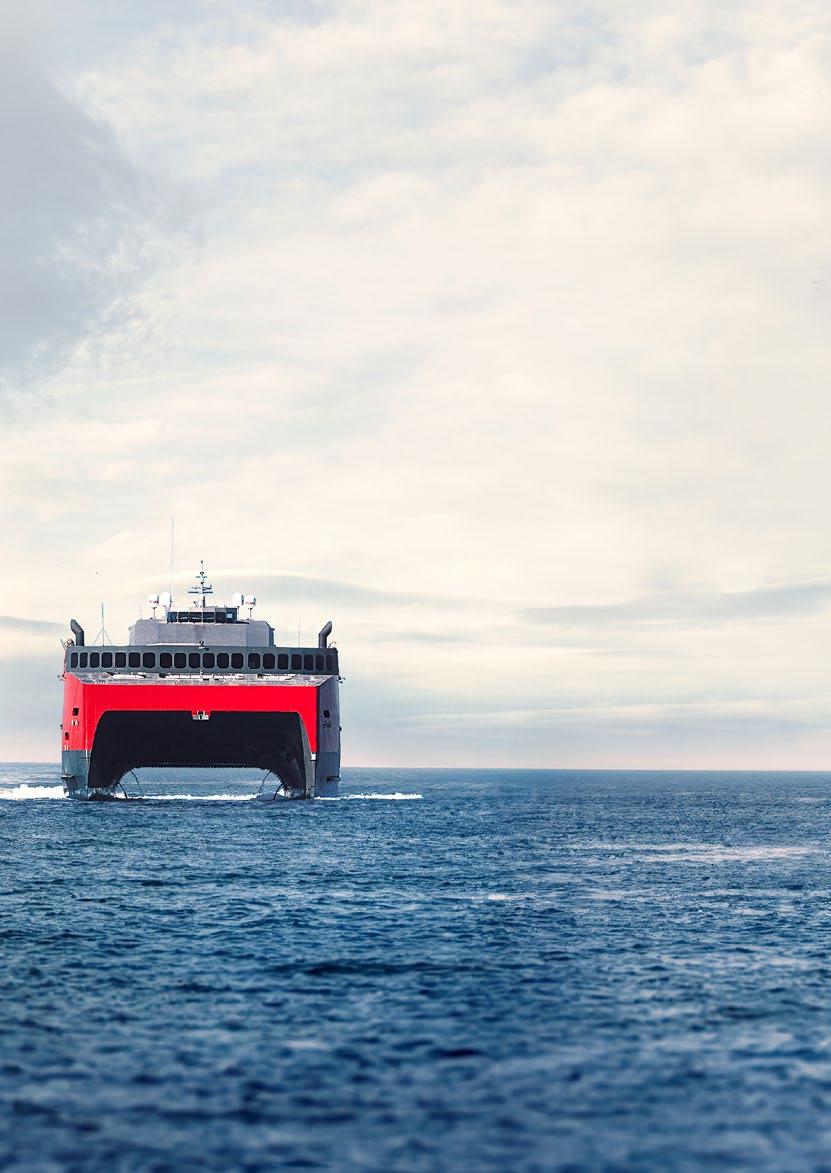

We have a continuous focus on reducing the food waste in our onboard restaurants.
Increased pricing of GHG emissions Policy Short
High costs to comply with new environmental regulation Policy Medium
We have invested heavily in a young fleet with industry-leading sustainability profile. Regulation regarding direct pricing of GHG emissions can potentially change. Such regulation could be quota-based (e.g. EU ETS) or fee-based (e.g. CO2 fee). Fjord Line follows developments in national and international policy discussions closely.
Including regulation supporting IMO's GHG strategy, such as EEDI, EEXI and CII, or with EUs climate strategy (e.g. EU taxonomy). Our fleet has passed the EEXI requirements with good margin. With regard to CII, we consider Fjord Line's current fleet well positioned to comply with such regulation in the medium term without need for costly modifications.
Reduced demand for tourism travel services due to shift in consumer mindset Market
Increasing awareness of environmental footprint may impact tourism-related travel negatively. We believe transparency is critical to maintain credibility in the marketplace and aim to provide good transparency of our environmental footprint and ESG performance.
Modal shift from road/ air to sea transport
Sea transport often provides a relative advantage over road/air transportation in terms of environmental footprint. Increasing awareness of CO2 emissions and the energy efficiency of Fjord Line's fleet may positively impact Fjord Line freight volumes. Renewable fuels and infrastructure
Fjord Line has positive experience from LNG. We now invest in renewable fuels (LBG) and evaluate other alternative fuels from a holistic perspective, including safety, performance, and infrastructure.
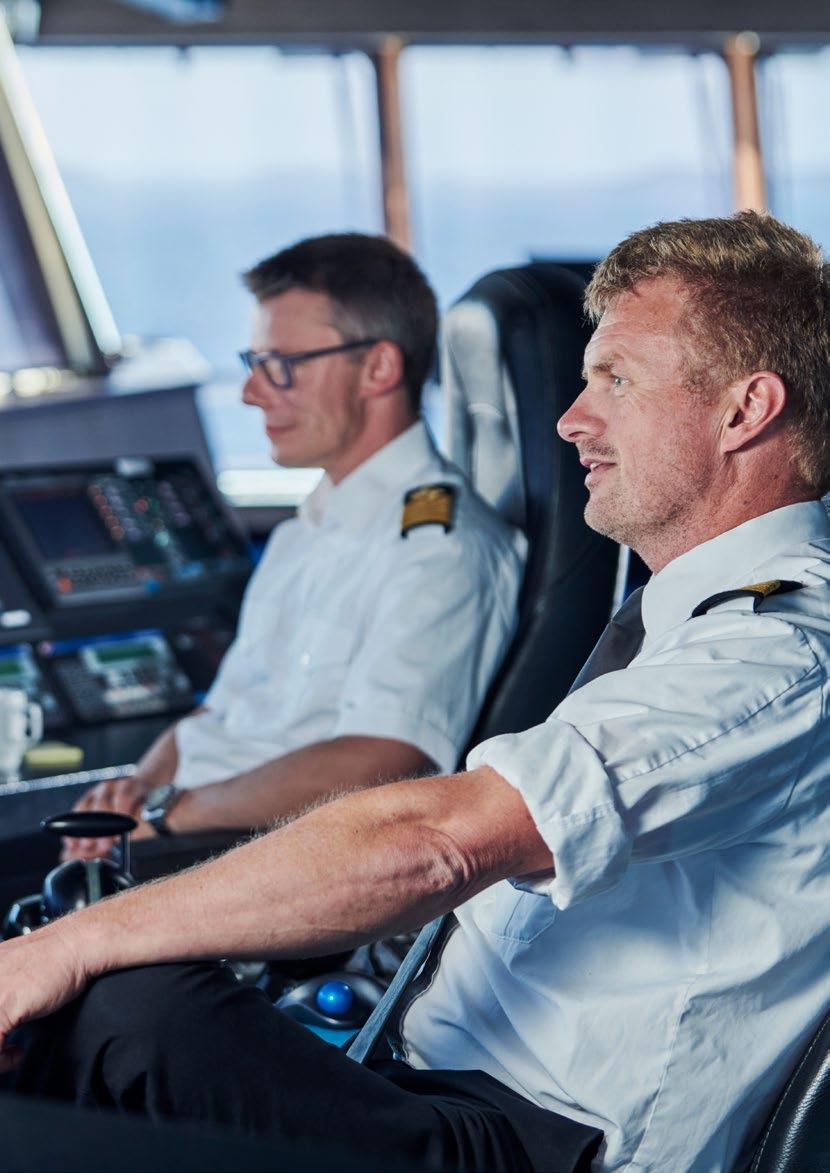
Fjord Line AS is the parent company of the Fjord Line Group. The Group is Norway’s second largest shipping company in international passenger traffic and freight transportation between Norway and EU.
The Group has one of the youngest and most modern and ecofriendly fleets in the cruise ferry segment in Europe. In 2023 the fleet consisted of four vessels whereof three are flying the Danish flag and one is flying the Norwegian. Two of the Group’s cruise ferries have dual fuel engines and can be propelled by either Liquified Natural Gas (LNG) or Marine Gas Oil (MGO). LNG produces up to 23% lower carbon emissions compared to diesel engines. Nitrogen oxide emissions (NOx) from these vessels are as much as 91% lower and emissions from Sulphur (SOx) and soot (PM) are virtually eliminated. The other two vessels use MGO which emits considerably less Sulphur emissions than traditional marine fuels such as Heavy Fuel Oil (HFO). The Group has in 2023 operated three routes between Norway and Denmark, one route between Norway and Sweden, and a domestic route between Bergen and Stavanger.
Fjord Line is headquartered in Egersund and has at the end of 2023 operative offices in Hirtshals, Bergen, Stavanger and Kristiansand. Langesund, Sandefjord and Strömstad have been closed as operative offices during 2023. Average number of employees (FTE) in the Group during 2023 has been 624 (619 in 2022).
During the first half of 2023 our operations with MV Bergensfjord and MV Stavangerfjord in the port of Langesund was replaced by the port of Kristiansand to secure a stronger customer offering. In October 2023, Fjord Line terminated its operations on the route between Sandefjord in Norway and Strömstad in Sweden. The termination also led to the closure of the Sandefjord and Strömstad offices.
With regular and daily departures between three ports in Norway and Hirtshals in Denmark, the Group recognizes its important role in the transportation of passengers and goods between Norway and the European continent.
Fjord Line transported 1,123,500 passengers and 28,500 freight units in 2023.
The Groups vision is to be the best, most loved and profitable ferry company in Scandinavia. Fjord Line aim to achieve this by providing the best experience throughout the customer journey, further strengthening our positioning and brand awareness and, finally, be a leader within sustainable, cost and energy efficient operations. Everything we do is with vigor, responsibility, respect and commitment.
The Groups revenues arises from three main business areas. All ticket revenues within the Group are generated in business area Travel and consists of transport-, cruise-, group-, package-, and conference ticket revenue streams.
All onboard revenues are generated within the business area Onboard Services and include revenue streams mainly from the retail and food & beverage operations.
Business area Freight generates its revenues from sales and transportation of trucks, trailers, articulated vehicles, specialized or out-sized cargo and on-deck shipments, and from forwarding services.
Representing a new technological standard, HSC Fjord FSTR is equipped with 16 electric vehicle charging stations and was the first passenger ferry in Norway to offer this.
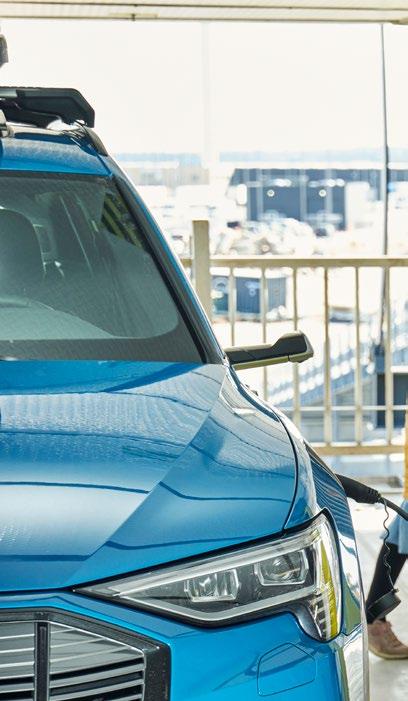
The cruise ferries MV Stavangerfjord (launched in 2013) and MV Bergensfjord (launched in 2014) operate the routes between Bergen – Stavanger – Hirtshals and Hirtshals – Kristiansand.
The high-speed catamaran HSC Fjord FSTR was delivered in February 2021 and operates the route Kristiansand – Hirtshals. HSC Fjord FSTR serves to meet increased customer demand for higher capacity and comfort, enabling more departures and longer sailing season, while improving environmental efficiency.
Representing a new technological standard, HSC Fjord FSTR is equipped with 16 electric vehicle charging stations and was the first passenger ferry in Norway to offer this.
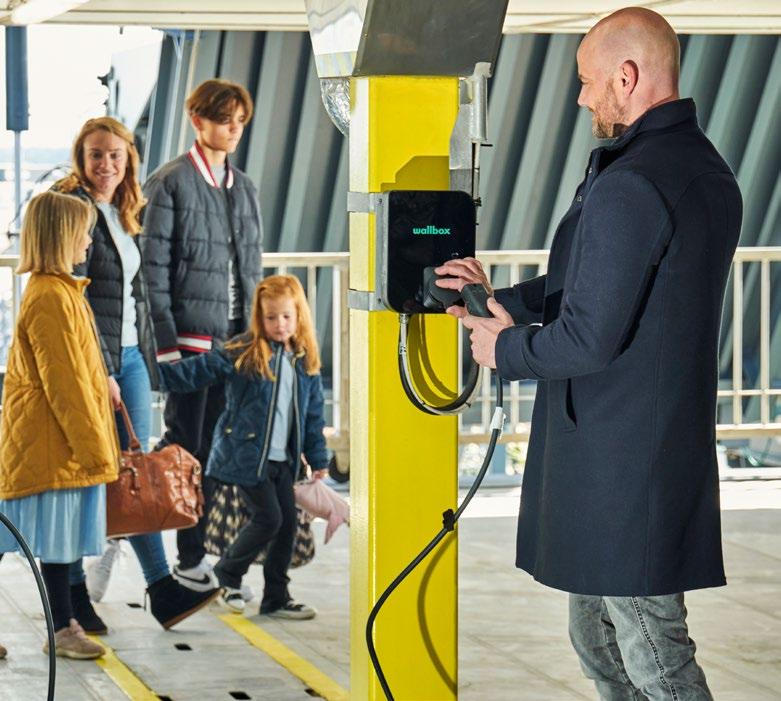
The day ferry MV Oslofjord (launched in 1993, rebuilt in 2014) is customized for the route Sandefjord – Strömstad and was put into operation as the company’s first vessel on the route on 20 June 2014. The ship was reflagged to fly the Norwegian flag during the spring of 2021. The ship is planned for disposal as a consequence of the termination of our operation on the route between Sandefjord and Strömstad
HIGHLIGHTS FROM 2023
2023 has been a year of significant changes in Fjord Line. The group has successfully completed strategic initiatives and investments to strengthen our business in a challenging geopolitical and macroeconomic environment, and to strengthen and extend the customer offerings to deliver even better, more, and new customer experiences in line with the new strategy.
Fjord Line has successfully completed extensive strategic initiatives and investments in 2023, to ensure the solid foundation for Fjord Line’s future development, profitability, and growth. This includes strategic initiatives such as; rebuilding LNG-ships from single-fuel to dual-fuel engines, route terminations, and introduced new customer offerings on the south corridor between Hirtshals and Kristiansand including a new domestic route between Kristiansand and Stavanger/Bergen in the beginning of 2024.
In October 2023, Fjord Line terminated its operations on the route between Sandefjord in Norway and Strömstad in Sweden. The termination was driven by strategic considerations to align our customer offerings with our vision and long-term strategy, anchored around profitable development of our core business
772
OUR TRAVELLERS
2023 in numbers EMPLOYEES
4 SHIPS
12,6%
FREIGHT UNIT MARKET SHARE
20,3%
PASSENGER MARKET SHARE
on the routes between Norway and Denmark. The termination led to organizational changes as we closed the Sandefjord and Strömstad offices, moving towards a leaner organizational set-up for the entire business. This unfortunately led to the departure of many of our valued employees.
Our new foundation - “New Fjord Line” - is an essential milestone towards increased competitiveness, profitable growth, and scale. With this foundation in place, we are now prepared to advance the development of Fjord Line further. Moving forward, we will continue to implement our new strategy.
1,123,500 PASSENGERS
375,200 CARS 2023 2735 TRIPS
1030 COACHES
28,500 FREIGHT UNITS
28,9%
PASSENGER VEHICLE MARKET SHARE
In 2023 the Group transported 1,123,500 passengers, compared to 1,253,500 passengers in 2022; an decrease of 10 percent. The number of passenger vehicles decreased in the same period to 375,200 from 404,200. The Group transported 28,500 freight units compared to 52,400 freight units in 2022; an decreas e of 46 percent.
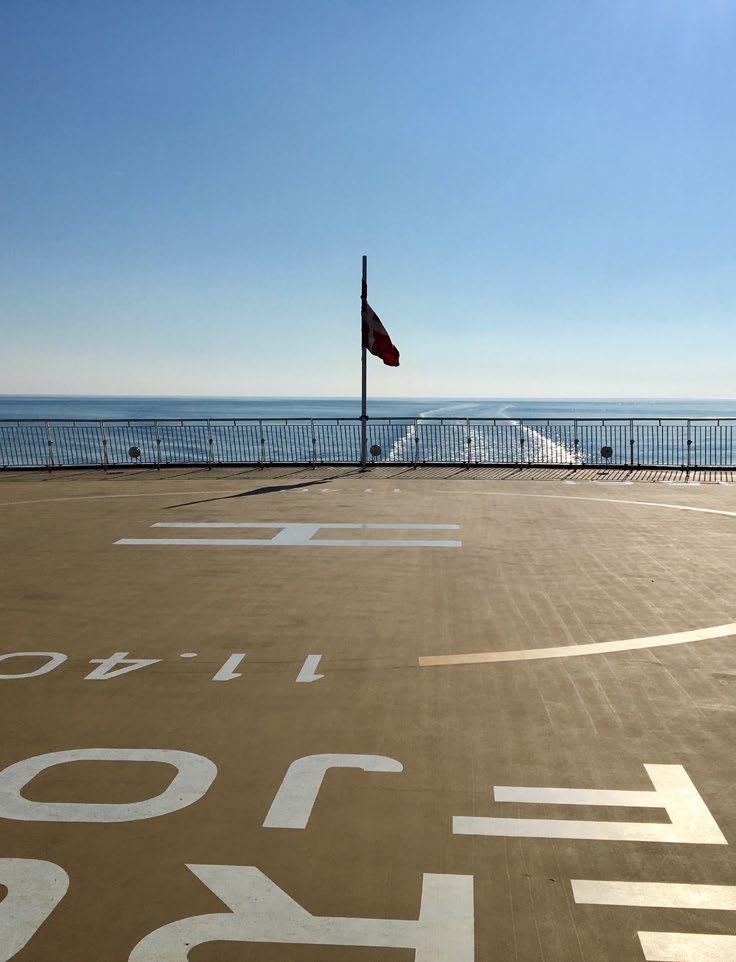
The Group’s operating income was MNOK 1 469 in 2023, compared to MNOK 1 666 in 2022. The Group’s operating expenses ex. depreciation were MNOK 1 472 in 2023, compared to MNOK 1 600 in 2022. The operating expenses in 2023 include write-downs related to terminated operations of MNOK 218.
The Group’s operating result (EBIT) in 2023 shows a loss of MNOK 469, compared to a loss of MNOK 226 in 2022.
Further on, the Group’s net financial expenses are MNOK 334 in 2023, compared to corresponding expenses of MNOK 182 in 2022. Result before tax for the Group was a loss of MNOK 803 in 2023, compared to a loss of MNOK 408 in 2022. Result after tax was a loss of MNOK 823 in 2023, compared to a loss of MNOK 411 in 2022.
The parent company Fjord Line AS` result before tax was a loss of MNOK 366 in 2023, compared to a loss of MNOK 339 in 2022. Fjord Line’s loss of MNOK 366 after tax is proposed transferred to uncovered loss. Subsequently the book equity of the parent company amounts to MNOK 484.
Fjord Line AS has accumulated basis for deferred tax asset of MNOK 2 290, which implies a deferred tax asset (22 per cent) of MNOK 504 at full capitalization. Based on the positive long-term future prospects of the company, the Board of Directors found that it has convincing evidence that future earnings will justify capitalization of deferred tax asset. Furthermore, the Board of Directors has in accordance with a precautionary approach decided not to further increase capitalization of deferred tax arising from the increase in loss carried forward in 2022 and 2023.
CASH FLOW AND FINANCIAL STRUCTURE
The Group’s liquid funds have decreased by MNOK 78 in 2023 compared to an increase of liquid funds of MNOK 16 in 2022. The increase consists of the following main elements:
• Cash flow from operational activities: MNOK 122 (MNOK 7 in 2022)
• Cash flow from investing activities: MNOK -356 (MNOK -208 in 2022)
• Cash flow from financing activities: MNOK 156 (MNOK 218 in 2022)
The Group’s total balance sheet is MNOK 4,446 per 31 December 2023, compared to MNOK 4,413 per 31 December 2022. Fjord Line AS’ total balance sheet is, however, MNOK 4,285 per 31 December 2023 compared to MNOK 4,206 per 31 December 2022.
Interest bearing debt made MNOK 3,355 per 31 December 2023 compared to MNOK 3,294 per 31 December 2022.
The group’s equity is MNOK 669 per 31 December 2023, compared to an equity of MNOK 891 per 31 December 2022.
The Group’s liquid funds made MNOK 179 per 31 December 2023, including unused credit facilities of MNOK 39.
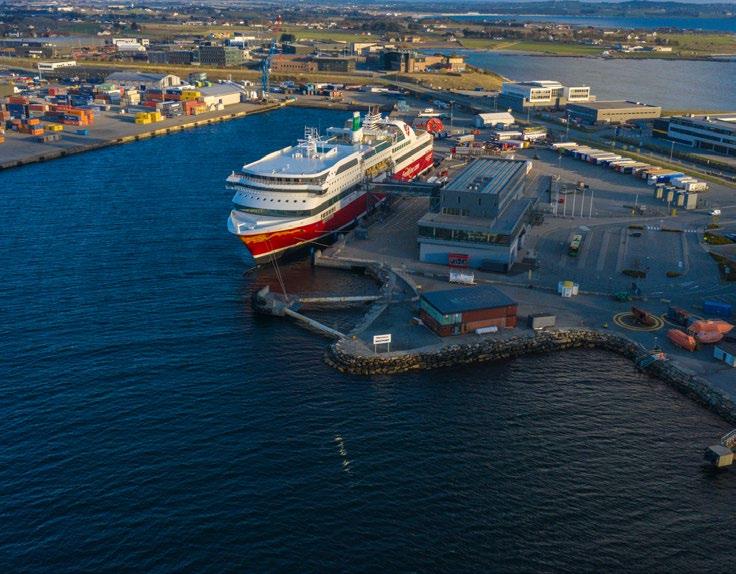
Exchange rate and interest rates
Per December 31.12.2023 the Group has interest bearing debt of MNOK 3,355, including loans in EUR and DKK, constituting in total MNOK 3,075. The Group is exposed to interest risk and currency risk on these loans. The risks are, however, partly eliminated through the fact that parts of the liabilities are hedged through fixed interest rate agreement, and that parts of the revenues and expenses are denominated in both EUR and DKK, as well as in NOK.
The Group is also exposed to fluctuations in the exchange rate of USD through purchase of fuel.
Price variations of bunker
The Group is exposed to fluctuations in bunker prices, and the risk is not mitigated through hedging contracts for LNG and MGO
at year end 2023. Furthermore, the dual-fuel conversion of MS Stavangerfjord and MS Bergensfjord enables the sister ships to seamlessly switch between LNG and MGO.
Per 31.12.23 the Group had financial debt covenant connected to liquidity. Several financial covenants are waived as a result of negotiations with senior lenders. The company’s Board of Directors and management are continuously monitoring the financial debt covenants, and per 31 December 2023 the company is compliant with all active covenants.
Fjord Line’s customer base comprises a diversified mix of customer segments, which reduces risk related to individual markets.
Fjord Line recognizes the need to conduct business in line with high standards for environmental, social and governance (ESG) concerns.
Fjord Lines`code of conduct is founded on human rights as well as the value of diversity and inclusion. It sets out the standards defining how we operate every day and everywhere. The code of conduct governs our relationships with clients, suppliers, stakeholders and each other. It requires all employees to adhere to the highest levels of professional conduct and underpins the reputation and trust Fjord Line commands. Routines for reporting any breach of our codes of conduct are in place and available for all employees. Whistleblowers are protected through these routines to ensure that there are no hindrances or risks to filing a report.
Fjord Line has working procedures to reduce the risk of corruption. Corruption is a risk especially related to large procurements. We reduce this risk through our procurement policy that calls for tender processes for large purchases and an approval process that ensures that all such purchases are evaluated objectively and by several people. The whistleblower function is open for reports on suspected corruption related to procurement or otherwise.
The major sharehoders per 31.12.2023 were as follows:
Fjord Line Holding AS 100%
Fjord Line has formalized a due diligence process and supporting measures to address adverse impacts on fundamental human rights and decent working conditions. The due-diligence process is carried out in accordance with the OECD guidelines for Multinational Enterprises in accordance with §4 in the Norwegian transparency act. Written requests as stated in section 6 can be sent to transparency@fjordline.com.
The company has a groupwide Safety Management System (SMS) in place. The system is developed in accordance with the international “ISM-code”, to ensure safe management and operation of ships and for pollution prevention. In addition, Fjord Line complies with a number of international regulations aimed at ensuring safe and secure maritime passenger transport. Fjord Line decided in 2022 to go forward in implementing a group wide management system including all our operation both onboard and onshore.
MAJOR OWNERS PER 31.12.2023
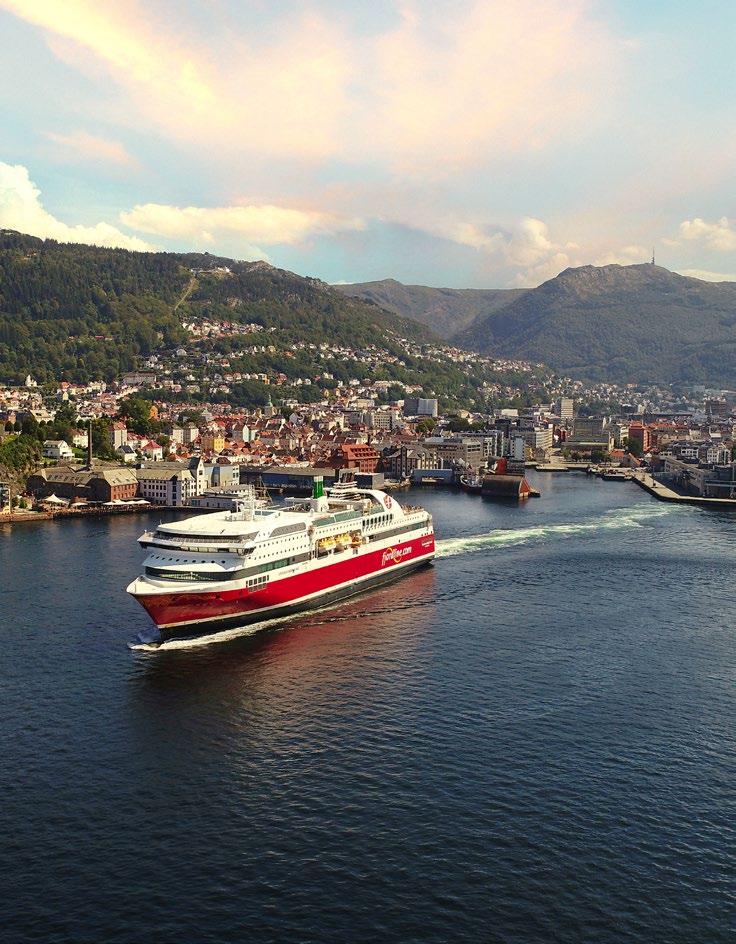
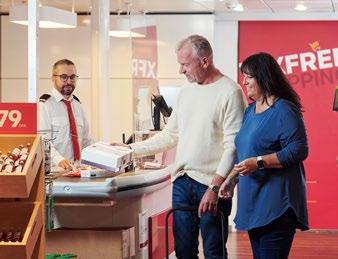
The directors and officers of Fjord Line AS are covered by a D&O Liability Insurance. The insurance covers personal legal liabilities including defense and legal costs. The officers and directors of the parent company and all subsidiaries (owned more than 50 percent) are covered by insurance. The cover also includes employees in managerial positions or employees who become named in a claim or investigation.
Fjord Line operates a business which causes pollution of the external environment. The Group complies with applicable laws and regulations in the area and wishes to minimize its environmental footprint.
Fjord Line’s fleet has a class-leading sustainability profile. MV Bergensfjord and MV Stavangerfjord run on LNG which produces up to 23% lower carbon emissions compared to diesel engines. Nitrogen oxide emissions (NOx) from these vessels are as much as 91% lower and emissions from Sulphur (SOx) and soot (PM) are virtually eliminated. Fjord Line has converted the ships from single-fuel LNG to dual-fuel LNG/MGO enabling the two LNGships to switch between LNG and MGO.
HSC Fjord FSTR and MV Oslofjord run on MGO. MGO emits considerably less Sulphur emissions than traditional marine fuels such as HFO. The catamaran HSC Fjord FSTR, is a new-build to replace HSC Fjord Cat and operates with an estimated 32% less GHG emissions per passenger compared to its predecessor.
Going forward, Fjord Line will continue to improve operating and technical aspects of the fleet and operations, to continue our positive momentum of increasing energy efficiency.

Fjord Line holds a deep commitment to our social responsibility and aim to be a responsible contributor to society.
Fjord Line’s ESG-strategy is closely aligned with our mission, vision, and core values, serving as an essential component and prerequisite for our success. Our people serve as the cornerstone of our success, and Fjord Line’s ability to attract, retain, and develop talented individuals at all levels is crucial in fulfilling our mission and vision.
During 2023 we terminated our operations on the route between Sandefjord in Norway and Strömstad in Sweden, and our operation in the port of Langesund. The terminations led to organizational changes as we closed all operations with MV Oslofjord and the Sandefjord, Strömstad and Langesund offices, moving towards a leaner organizational set-up for our entire business. This unfortunately led to the departure of many of our valued colleagues. There has been a strong focus on securing a respectful and responsible process in relation to those of our colleagues, who would no longer be part of Fjord Line as for those who otherwise were negatively affected by the organizational changes and in the way we work.
The engine conversions in the first part of the year resulted in two of our ships being out of operation for several months and consequently many of our seagoing employees were out of operation during this period. Instead of dismissals, Fjord Line chose to invest in competence development by implementing a training project funded in part by the Adult Training Program (VEU). In collaboration with the local educational institutions in and around Hirtshals, Fjord Line completed a total of 2 920 competence development days, including courses in language

training, hotel operation, cooking, health, conflict management, cleaning, IT, safety, project management, etc.
Employee satisfaction in Fjord Line is measured annually basis and more frequent surveys are considered. The Group focus on effective, long term action plans to improve employee satisfaction. Initiatives to reduce the level of sick leave and increased engagement are among the continuous focus areas of our employee satisfaction strategy. Our employees’ feedback from recent surveys shows a continued strong employee satisfaction.
Fjord Line is running a “No Blame Open Minded Safety Culture Program” to make the organization resilient and sustainable. The company has therefore focused on vigilance and that every incident must be reported, regardless of severity. In 2023 14 work accidents were registered. The majority of accidents were in the accommodation and galley areas. Of these accidents, 2 accidents were considered as serious. The number of work accidents is significantly reduced compared to a normal year (43 incidents in 2019). Fjord Line continuously work to reduce the level of work accidents through several initiatives. Sea- and landbased employees regularly conduct safety and emergency drills including lifeboat drills and evacuation exercises, and functional tests of rescue equipment are regularly carried out onboard the ships.
A guideline for systematic follow-up on sick leave was introduced in 2017. The absence due to illness in the Group was 3,5 percent in 2023 split on 4,3 percent for seagoing employees and 2,3 percent for shore employees. This equals an increase in total absence due to illness of 0,2 percent points compared with 2022 (3,3). Overall absence rates for seagoing employees are above targets ≤ 4% and for shore employees, the number is slightly above target ≤ 2%.
We will maintain our strong focus on good follow-up on absence. While there is continuous focus on reducing absence rates, overall absence rates are considered within targets.
In 2023, the Group had 281 shore-based and 491 sea-going employees, representing a total of 478 males and 294 females. In Fjord Line AS the equivalent number of employees was 182, consisting of 95 women and 87 men.
The company is continuously working to avoid discrimination based on gender, age, ethnicity etc. both with respect to existing and new employment.
The Group’s top management comprising at year end of 6 employees, 1 employee is female. The Board of Directors in Fjord Line are composed of 6 men and 1 woman. Based on an assessment of number of employees and job category the Board of Directors have not found it necessary to implement special measures with respect to gender equality. The Group will, however, continuously focus on this topic.
The requirements of the Norwegian Accounting Act § 3-3c and The Norwegian Transparency Act § 26a been covered in a separate report which is available on Fjordline.com. Furthermore, the topic will also be covered in the annual report for 2023.
After two years of a global pandemic and government-imposed travel restrictions, Fjord Line had the best-ever high season revenue wise in 2022. Unfortunately, increases in the LNG fuel prices – caused e.g. by Russia’s invasion of Ukraine - led to a non-sustainable financial situation for Fjord Line which resulted in Fjord Line deciding to convert the two vessels Stavangerfjord and Bergensfjord from single-fuel LNG to dual-fuel MGO/LNG
vessels. The conversions took place in the first half of 2023 with Stavangerfjord undergoing conversion from January until May, and Bergensfjord from February until June. The conversions of the vessels have been a success and were conducted on time, by Fosen Yard. Fjord Line are pleased to acknowledge that the conversions have provided the company with the necessary flexibility to ensure sustainable operations of the vessels regardless of fluctuation in LNG or MGO prices. Even though Fjord Line now has the option to operate Stavangerfjord and Bergensfjord on MGO Fjord Line remain steadfast on its mission to be environmentally friendly and have since the conversion mainly operated the vessels on LNG.
Fjord Line has effectuated various strategic changes during 2023 such as the termination of the Sandefjord-Strømstad route, and the change of destination from Langesund to Kristiansand for Stavangerfjord and Bergensfjord. Fjord Line has also closed down its offices in Sandefjord and Strømstad, relocating employees and/or functions to Bergen and Hirtshals. Fjord Line has furthermore concluded on the sale of the vessel Oslofjord which is scheduled to be delivered to new owners in the end of April or beginning of May. With the beforementioned measures Fjord Line
is in good route to deliver on its 3-year strategic plan for 2023 –2026 with 2023 being quite a transitional year for the Group.
2024, which is the first normal year of operation since 2019, is so far proving to be a good year for the company without any extraordinary events of significance for its operations. To provide the Group with a financial runway and sufficient flexibility to support its normal operations and allow the management to follow up on the strategic plan for the coming years, Fjord Line has – together with its board and shareholders - initiated a process to improve its working capital in the form of e.g. refinancing or capital injection. The process is expected to be concluded during the second half of 2024.
The Group is not involved in any litigations.
Based on the information above and in accordance with the Accounting Act § 3-3a it is confirmed that the financial statements for 2023 have been prepared under the assumption of going concern.



Heidi Nag Flikka Board Member
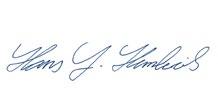
Board Member

Our focus remains to reinforce excellence in all our business fundamentals.
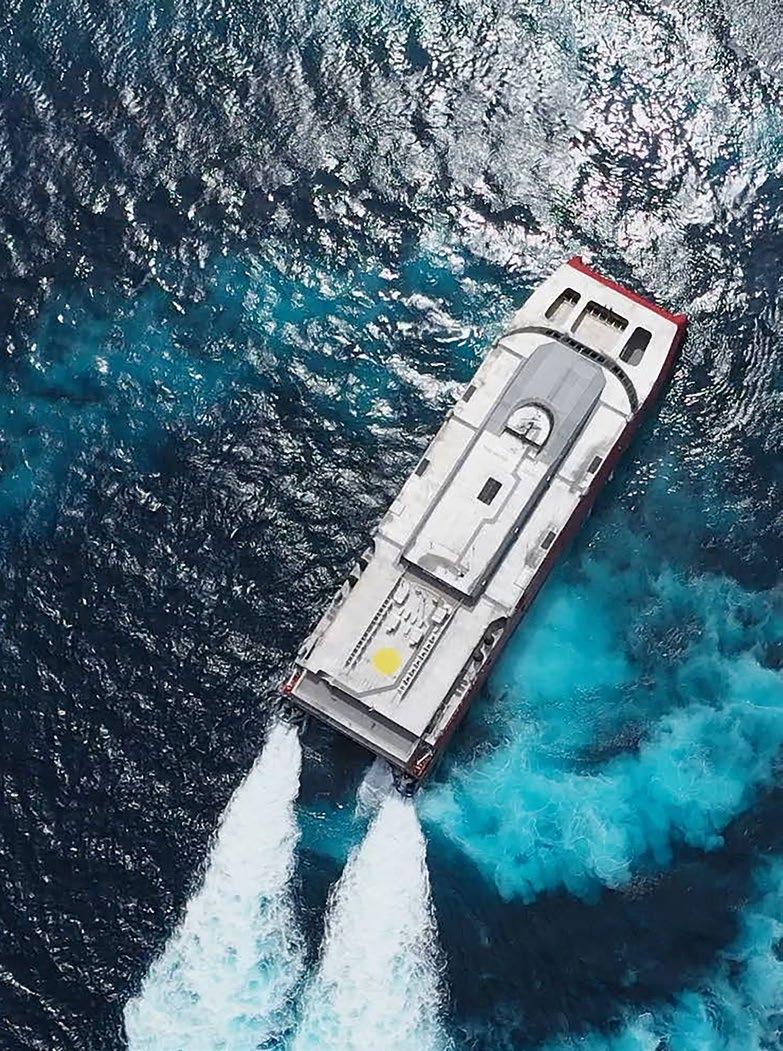

income statment (1,000 NOK)
Consolidated balance sheet (1,000 NOK)



Heidi Nag Flikka Board Member

Board Member
Below are stated significant Accounting Policies used in the preparation of the consolidated financial statements. The consolidated financial statements have been prepared in accordance with simplified IFRS (International Financial Reporting Standards).
The consolidated financial statements comprise the parent company Fjord Line AS and the subsidiaries, Fjord Line Crewing AS (Norway), Next Green Energy AS, Hirtshals LNG AS, Fjord Line Danmark A/S, Fjord Skibsholding I A/S, Fjord Skibsholding II A/S, Fjord Skibsholding III A/S, Fjord Skibsholding IV A/S and Fjord Skibsholding V A/S. The seven last mentioned companies are domiciled in Denmark and are 100% owned subsidiaries.
Subsidiaries are entities where the group has the power to govern the entity’s financial and operational policies (control).
When the group disposes of a subsidiary/ceases to have control, any retained interest in the entity is remeasured to its fair value at the date when control is lost, with the change in carrying amount recognised in profit or loss. The fair value is the initial carrying amount for the purposes of subsequently accounting for the retained interest as an associate, joint venture or financial asset.
Intercompany transactions, balances etc. have been eliminated in the consolidated financial statements.
For consolidation purposes the Danish companies are considered to have functional currency in DKK.
The preparation of financial statements requires the use of certain critical accounting estimates. It also requires management to exercise its judgment in the process of applying the group's accounting policies. Areas involving a higher degree of judgment or complexity, or areas where assumptions and estimates are significant to the consolidated financial statements are deferred tax assets, residual value of ships, useful life of ships,
capitalization and depreciation of periodic maintenance and provision for incurred costs.
Revenue is measured at the fair value of the consideration received or receivable. Revenue is presented net of returns, trade allowances, rebates and amounts collected on behalf of third parties.
The specific accounting policies for the group’s main revenue generating activities are as follows:
Transportation/ticket:
Ticket revenue is recognized over time when the actual transport is executed. The route and crossing from start point to the end destination is fairly short and within 24 hours.
The portion of the sales income, which relates to future service is reflected in the balance sheet as unearned income from the sale and is then recognised in line with the service work performed. This prepayment is normally not discounted because of a short period from pre-payment to executing of the transport.
Tax-free sale:
Tax-free sale is recognized at point in time of sale.
Food and beverage sale: Food and beverage sale are recognized at point in time of sale.
Government grants related to Covid-19 is recorded as reduction of other operating expenses. All periods applied for government grant in 2022 is included in the financial statement.
Assets intended for long term ownership or use have been classified as fixed assets. Assets relating to the trading cycle have been classified as current assets. Receivables are classified as current assets if they are to be repaid within one year after the transaction date. Similar criteria apply to liabilities. First year’s instalment has been classified as current liabilities.
Expenses for intangible assets are reflected in the balance sheet when it is considered likely that the future financial benefits relating to the asset will be received by the company and the acquisition cost of the asset can be reliably measured.
Property, plant and equipment are reflected in the balance sheet and depreciated over the assets’ expected useful life on a straight-line basis. Direct maintenance of an asset is expensed under operating expenses as and when it is incurred. Additions or improvements are added to the asset's cost price and depreciated together with the asset.
The group's ships with associated additions etc. are owned by the Danish subsidiaries. The book value of ships is calculated based on acquisition cost, less depreciation and impairment, if any. Facilities under construction are capitalized in line with assumed progress.
Investments/expenses that are not included in the contract, as inspection costs, costs connected to project organisation, legal costs, financing costs and other related costs are considered as part of the acquisition cost and recorded in the balance sheet.
Grants from the NOx-fund related to investments are recorded/ accrued in line with the depreciation profile of the assets that the grants relate to. The accrual is classified as reduction of depreciation cost in the income statement. NOx-grants not recognised over profit or loss are classified as reduction of ship values in the balance sheet.
The book values of the group's ships and other operating assets are individually tested for impairment when events or changes in circumstances indicate that the book value is no longer present. If such indications occur and book value exceeds recoverable amount, then the asset is impaired to recoverable amount.
The ships are decomposed into ship/ship furnishing and periodical maintenance for depreciation purposes They are depreciated straight-line over a defined useful life. An assumed residual value of the ships at the expiry of the useful life is taken into consideration. The ships must continuously be presented for control, which implies regular docking and classification. Periodical maintenance is recognised in the balance sheet in connection with docking and depreciated till next assumed docking.
Lease contracts where the group is a lessee are capitalized. Upon commencement of the lease the right-to-use asset is recognized at cost being the present value of the lease payments in the contract as defined by IFRS 16 in addition to initial direct costs. The corresponding lease liability is recognized in the balance sheet at present value using the interest rate implicit in the lease, if that rate can be readily determined, or else
the lessee’s incremental borrowing rate. The lease liability is subsequently increased by the effective interest in the lease and reduced by payments made. The lease liability is also reassessed subsequently if the payments or the interest rate changes. The change in liability is added to or deducted from the right-of-use asset.
The right-of-use asset acquired under leases is depreciated over the asset’s useful life or the lease term, if shorter, if the lease does not transfer ownership at the end of the lease term, or there is no purchase option that is in the money. The right-of-use asset is tested for impairment for similar assets owned by the entity.
Inventories of purchased goods are valued at the lower of acquisition cost according to the FIFO-principle and net realisable value. Net realisable value is the estimated selling price in ordinary activities deducted estimated sales expenses.
At initial recognition, the group measures a financial asset at its fair value plus, in the case of a financial asset not at fair value through profit or loss, transaction costs that are directly attributable to the acquisition of the financial asset. Transaction costs of financial assets carried at fair value through profit or loss are expensed in profit or loss.
Dividends on financial assets at fair value through profit or loss and fair value through other comprehensive income are recognized in profit or loss as part of revenue when the group’s right to receive payments is established.
Interest income from financial assets at fair value through profit or loss is included in the net gains/(losses). Interest on other financial assets are calculated using the effective interest method and recognized in profit or loss as revenue.
For accounts receivables, the lifetime credit loss is recognized upon initial recognition of the asset. For other debt instruments, twelve months estimated credit loss is recognized upon initial recognition. When a significant increase in the expected credit loss is observed, lifetime credit losses is estimated and recognized.
Derivatives are initially recognized at fair value on the date a derivative contract is entered into and are subsequently remeasured to their fair value at the end of each reporting period. The accounting for subsequent changes in fair value depends on whether the derivative is designated as a hedging instrument, and if so, the nature of the item being hedged.
The group documents at the inception of the hedging transaction the relationship between hedging instruments and hedged items, as well as its risk management objective and strategy for undertaking various hedge transactions. The group also documents its assessment, both at hedge inception and on an ongoing basis, of whether the derivatives that are used in hedging transactions have been and will continue to be highly effective in offsetting changes in fair values or cash flows of hedged items.
The full fair value of a hedging derivative is classified as a noncurrent asset or liability when the remaining maturity of the hedged item is more than 12 months; it is classified as a current asset or liability when the remaining maturity of the hedged item is less than 12 months.
Trading derivatives are classified as a current asset or liability.
Cash flow hedge
The effective portion of changes in the fair value of derivatives that are designated and qualify as cash flow hedges is recognized in other comprehensive income and accumulated in reserves in equity. The gain or loss relating to the ineffective portion is recognized immediately in profit or loss within other income or other expense.
Amounts accumulated in equity are reclassified to profit or loss through other comprehensive income in the periods when the hedged item affects profit or loss (for instance when the hedged interest rate payment that is hedged takes place). The gain or loss relating to the effective portion of interest rate swaps hedging variable rate borrowings is recognized in profit or loss within ‘finance costs’.
When a hedging instrument expires or is sold or terminated, or when a hedge no longer meets the criteria for hedge accounting, any cumulative gain or loss existing in equity at that time remains in equity and is recognized when the forecast transaction is ultimately recognized in profit or loss. When a forecast transaction is no longer expected to occur, the cumulative gain or loss that was reported in equity is immediately reclassified to profit or loss.
Derivatives that do not qualify for hedge accounting
Certain derivative instruments may not qualify for hedge accounting. Changes in the fair value of any derivative instrument that does not qualify for hedge accounting are recognized immediately in profit or loss and are included in net other financial income and expenses.
Borrowings are initially recognized at fair value, net of transaction costs incurred. Borrowings are subsequently measured at amortized cost. Any difference between the proceeds (net of transaction costs) and the redemption amount is recognized in profit or loss over the period of the borrowings using the effective interest method. Fees paid on the establishment of loan facilities are recognized as transaction costs of the loan to the extent that
it is probable that some or all of the facility will be drawn down. In this case, the fee is deferred until the draw down occurs. To the extent there is no evidence that it is probable that some or all of the facility will be drawn down, the fee is capitalized as a prepayment for liquidity services and amortized over the period of the facility to which it relates.
Borrowings are removed from the balance sheet when the obligation specified in the contract is discharged, cancelled or expired. The difference between the carrying amount of a financial liability that has been extinguished or transferred to another party and the consideration paid, including any non-cash assets transferred or liabilities assumed, is recognized in profit or loss as other income or finance costs.
Borrowings are classified as current liabilities unless the group has an unconditional right to defer settlement of the liability for at least 12 months after the reporting period.
Borrowing costs
General and specific borrowing costs that are directly attributable to the acquisition, construction or production of a qualifying asset are capitalized during the period of time that is required to complete and prepare the asset for its intended use or sale. Qualifying assets are assets that necessarily take a substantial period of time to get ready for their intended use or sale. Other borrowing costs are expensed in the period in which they are incurred.
Foreign currency translation
Items included in the financial statements of each of the group’s entities are measured using the currency of the primary economic environment in which the entity operates («the functional currency»). The consolidated financial statements are presented in NOK, which is the functional currency of the parent company and the group’s presentation currency.
The results and financial position of all the group entities (none of which has the currency of a hyper-inflationary economy) that have a functional currency different from the presentation currency are translated into the presentation currency as follows:
(i) Assets and liabilities for each balance sheet presented are translated at the closing rate at the date of that balance sheet.
(ii) The income statement shall be converted at the exchange rate at the time of the transaction. As an approach to this, average rates are used for the accounting period unless it is large single transactions or the exchange rate have varied so much that the approach does not give a true picture.
(iii) All resulting exchange differences are recognised in other comprehensive income and specified separately.
Transactions in foreign currency are translated to the functional currency at the current exchange rate at the transaction date.
The income tax expense or credit for the period is the tax payable on the current period’s taxable income based on the applicable income tax rate for each jurisdiction adjusted by changes in deferred tax assets and liabilities attributable to temporary differences and to unused tax losses.
Deferred income tax is provided in full, using the liability method, on temporary differences arising between the tax bases of assets and liabilities and their carrying amounts in the consolidated financial statements. However, deferred tax liabilities are not recognized if they arise from the initial recognition of goodwill. Deferred income tax is also not accounted for if it arises from initial recognition of an asset or liability in a transaction other than a business combination that at the time of the transaction affects neither accounting nor taxable profit or loss. Deferred income tax is determined using tax rates (and laws) that have been enacted or substantially enacted by the end of the reporting period and are expected to apply when the related deferred income tax asset is realized or the deferred income tax liability is settled.
Deferred tax assets are recognized only if it is probable that future taxable amounts will be available to utilize those temporary differences and losses.
Current and deferred tax is recognized in profit or loss, except to the extent that it relates to items recognized in other
comprehensive income or directly in equity. In this case, the tax is also recognized in other comprehensive income or directly in equity, respectively.
The Danish ship owning companies are subject to the Danish tonnage tax regime
A defined contribution plan is a pension plan under which the group pays fixed contributions to an insurance company. The group has no legal or constructive obligations once the contributions have been paid. The contributions are recognised as wage costs. A defined benefit plan is a pension plan that is not a defined contribution plan. Typically, defined benefit plans define an amount of pension benefit that an employee will receive on retirement, usually dependent on one or more factors such as age, years of service and compensation. The liability recognised in the balance sheet in respect of defined benefit plans is the present value of the defined benefit obligation at the balance sheet date.
The cash-flow statement is prepared in accordance with the indirect method.

Note 1 Intangible assets - group (Figures in the table in TNOK)
Write-down in the
Completed projects in 2023 are projects related to development of websites and WEB platform, with a depreciatcion
Note 2 Property, plant and equipment - group (Figures in the table in TNOK)
Grant not recognised through profit or loss per 31.12.2023 is TNOK 0 (TNOK 119.740 per 31.12.2022) and has been recognised in full in 2023. Ships, incl peridical maintenance, furnishing etc. contains a total of 5.489 TNOK under contruction as of 31.12.2023 (TNOK 121.723 per 31.12.2022) related to ships and 3.371 TNOK (TNOK 0 per 31.12.2022) under construction related to other maintenence and furnishing etc.
Rigth of use assets have a total obligation of TNOK 62 033 (TNOK 77.291 31.12.2022).
Grant not recognised through profit or loss is recognised as a reduction of the acquisition cost per 31.12. The grant is accrued/recognised in line with the depreciation profiles of the related ships and classified as reduction of depreciations.
Depreciation and book value of the ships per 31.12.2023
The Fjord Line group has 4 ships in the business at the reporting date;
1) "MS Oslofjord" (formerly MS Bergensfjord). This ship was under reconstruction in 2014 and has sailed in the route Sandefjord-Strømstad since 20 June 2014 .
2) "MS Stavangerfjord". This ship was delivered in July 2013.
3) "MS Bergensfjord". This ship was delivered in February 2014.
4) "Fjord FSTR". This ship was delivered in February 2021.
MS Oslofjord:
MS Oslofjord carrying value is 196.765 TNOK as of 31.12.2023.
The ship is planned for disposal as a consequence of the discontinuation of the route between Sandefjord and Strömstad. Furthermore, the ship has in line with a precautionary approach been written down to an estimated fair value in 2023.
MS Stavangerfjord
MS Stavangerfjord is depreciated linearly over 35 years, with salvage value 50 MNOK. Remaining depreciation period per 31.12.2023 is 24,5 years. Carrying value for the ship including periodical maintenance is TNOK 1.359.859 pr 31.12.2023.
Ship furnishing is depreciated over 5 - 20 years. Periodical maintenance/docking is depreciated linearly over 1 - 10 years.
MS Bergensfjord
The ship itself is depreciated linearly over 35 years, with salvage value 50 MNOK. Remaining depreciation period per 31.12.2023 is approx. 25 years. Carrying value for the ship including periodical maintenance is TNOK 1.262 557 pr 31.12.2023.
Periodical maintenance/docking and furnishing are depreciated linearly over 5 - 15 years.
Fjord FSTR
The ship itself is depreciated linearly over 25 years, with salvage value 50 MNOK. Remaining depreciation period per 31.12.2023 is 22,5
Carrying value for the ship including periodical maintenance is TNOK 808.748 pr 31.12.2023.
Ship furnishing is depreciated over 1 - 5 years. Periodical maintenance/docking is depreciated linearly over 1 - 10 years.
Note 3 Financial items - group (Figures in TNOK)
Other financial income and other financial expenses comprise the following:
Foreign exchange gains/foreign exchange loss intergroup receivable Fjord Line AS has non-current interest bearing receivables on the Danish subsidiaries amounting to a total of TNOK 2.692.755
statements. A specific installment plan for the loans the subsidiaries have to their parent company has not been established, however, the subsidiaries will use free liquidity for repayment.
Note 4 Investments in associated companies and other investments - grou
Visit Sørlandet AS
In 2010 Fjord Line AS acquired shares amounting to TNOK 50 in Visit Sørlandet AS. After 2010 there has been neither additions nor disposals. The investment is recognised in accordance with the cost method. There has not been any write-down of the holding of shares neither in 2021 nor in 2020.
Visit Telemark AS
Fjord Line AS invested TNOK 30 in Visit Telemark AS in 2016. The investment is recognised in accordance with the cost method. No write-down has been made.
Digital Platforms Eigersund SA Fjord Line AS invested TNOK 15 in Digital Platforms Eigersnud SA in 2022. The investment is recognised in accordance with the cost method. No write down has been ma
Green LNG A/S
In 2020 Fjord Line group acquired additional shares in Next Green Energy A/S, total amount invested is TDKK 932. Green LNG A/S is consolidated from the acquisition date in 2020. No write-down has been made.
Note 5 Inventories and fuel expenses - group (Figures in TNOK)
Write-down of TNOK 0 has been made of the inventory by year end (2,5 TNOK in 2022).
Expenses related to fuel are classified as other operating expenses in the income statemen For 2023 this amounts to TNOK 282.013 (TNOK 551.033 in 2022).
Note 6 Trade receivables - group (Figures in TNOK)
in the year
Received on receivables previously written off
Bad debts are included in the item "other operating expenses" in the income statement.
Note 7 Other current receivables - group (Figures in TNOK)
Note 8 Restricted funds and cash equivalents- group (Figures in
Note 9 Changes in equity - group (Figures in TNOK)
Note 11 Taxes - group
(Figures in TNOK)
Calculation of deferred tax/deferred tax asset allocated to the Norwegian activit
differences
for deferred
22% of the basis
(-deferred tax asset
tax (-deferred tax asset) recognised in the balance sheet
Deferred tax asset not recognised in the
Payable tax recognised in the balance sheet per 31.12.2023 connected to the Norwegian activity makes TNOK 0 (TNOK 0 per 31.12.2022).
Foreign subsidiaries
The Danish shipowning companies are under Danish law connected to a tonnage tax system and have calculated taxable income based on these conditions.
Further on, the Danish subsidiaries are jointly taxed. Tax 2023 for the Danish subsidiaries is TNOK 1 200 after utilization of tax losses carried forward (TNOK 0 in 2022).
The Danish subsidiaries received taxable grants in 2015. This was reflected in payable tax recognised in the balance sheet, TNOK 17.480 per 31.12.2015 which was allocated to the Danish subsidiaries.
As the grants are recognised as a reduction of the ships' acquisition cost, the grant is recognised through gains/losses in line with the depreciation of the ships. The grant is considered not to be comprised by IAS 12. Therefore a deferred tax asset corresponding to payable tax connected to the grant was recognised in the balance sheet upon receipt of the grant in 2015. This deferred tax asset is being reversed over the depreciation period of the ships.
Net book value of deferred tax asset per 31.12.2023 and 31.12.2022 relating to foreign subsidiary is listed below. The main element of this net amount (TNOK 22.434 per 31.12.2022) is thus connected to the mentioned grants.
The Board of Directors following a concrete assessment found that it has convincing evidence that future earnings will justify capitalization of deferred tax asset. The argument is sustained by the positive operating results prior to Covid-19/Energy crisis, combined with current long term business plans. Furthermore, the Board of Directors has in accordance with a precautionary approach decided not to further increase capitalization of deferred tax arising from the increase in loss carried forward in 2022 and 2023 connected to the Norwegian activity.
Note 12 Liabilities - group (Figures in table in TNOK)
*Debt to owners has been converted to equity in 2023.
Per 31.12.2023 the company has a negative balance on the group cashpool overdraft facility account of -122.6 MNOK (negative
The subsidiary Fjord Line DK A/S has an unused overdraft facility of 3 MDKK per 31.12.2023 (3 MDKK per 31.12.2022). Interest bearing debt to credit institutions (incl. leasing) -
of -340,4 MNOK per
**Excluding other non-current interest bearing debt and incl. first year's installment.
Interest bearing debt to credit institutions (incl. leasing) - distributed on currency per 31.12.2021 (figures in 1,00
**Incl. first year's installment
Borrowing in Euro and DKK
Borrowing in Euro and DKK is recognised in the balance sheet at current exchange rate per 31.12.2023 and 31.12.2022, cf. the table above.
Foreign exchange loss/gain in 2023 related to non-current borrowing in Euro and DKK is 183,906 MNOK.
Foreign exchange loss/gain in 2022 related to non-current borrowing in Euro and DKK is 46,9 MNOK.
Book value per 31.12. for the Euro-borrowings and DKK is as follows in NOK (figures in TNOK):
amount:
effect of the borrowings, incl. guarantee commission
Borrowing in DKK
Borrowing in DKK 31.12.2023 consists of a non-current loan to Danica Pension of TNOK 603.280. Total available loan facility is MDKK 400. The loan facility is issued in its entirity in 2018 and the debt in DKK to Danica Pension amounts to MDKK 400.
Installment plan non-current interest-bearing debt to credit institutions/mortgage loan, leasing debt and bond lo (Figures in TNOK)
Remaining loan per 31.12 3
Book value of mortgaged assets 31.12.2023: Ships 3 631 300 Prepaid ships 0 Receivables 80 389 Inventories 24 018 Total 3 735 707
Note 13 Operating income and other gains/losses - group (Figures in TNOK)
Note 14 Wage costs, number of employees, remunerations, loans to employees etc. - grou
(Figures in table below in TNOK)
No loan or gurarantee has been provided for CEO or any of the members of the Board of Directors. The CEO is included in the company's pension agreement, cf mentioned below.
According to the agreement, 20% of gross salary is allocated annually and the
The chief executive officer is entitled to a severance payment equivalent to 12 months’ salary without the right to holiday pay and pension rights, commencing at the time of expiry of notice period, when the resignation is at the request from the company.
Pensions
The company has taken on a pension savings agreement on behalf of the present CEO and another two individuals. The market value of the contributions/assets was TNOK 8.605 per 31.12.2023 (TNOK 7.235 per 31.12.2022).
Gross liability per 31.12.2023 is calculated to TNOK 10.021 related to these persons (TNOK 8.417 per 31.12.2022).
Net liability is thus TNOK 4.080 per 31.12.2023 (TNOK 3.059 per 31.12.2022), and is classified as pension liability in the balance sheet.
In addition the company has established a defined contribution pension scheme for its employees. The company pays fixed contributions to an insurance company. The company has no further obligations to pay once the contributions have been paid. The contribution constitutes from 2% to 4% of the employees' salary.
Auditor
Auditor's fee relates to the following services (exclusive of vat): (Figures in TNOK)
Note 15 Other current liabilities - group (Figures in TNOK)
Note 16 NOx-grants - group
The ship "MS Stavangerfjord" was delivered in July 2013, and the ship "MS Bergensfjord" was delivered in January 2014. Because the ships are gas powered (LNG), with related low emission, Fjord Line AS was granted a contribution from the NOx-fund. Per 31.12.2014 contributions of MNOK 147,2 in total were paid to Fjord Line AS connected to these projects. As a condition for the grant Fjord Line AS has been obliged to use "MS Stavangerfjord" and "MS Bergensfjord" in NOx-liable waters for at least 2 years from time of delivery.
Fjord Line AS received 0 MNOK in NOx-grants in 2023 (0 MNOK in 2022).
In the 2023-accounts MNOK 166 809 MNOK of the grants have been recorded (4,8 MNOK in 2022). The amount is classified as reduction of depreciation in the income statement. The recording of the NOx-grants through profit or loss is accrued in line with the depreciation profile of the operating assets that the grants relate to.
Below is a list of accounting values (figures in TNOK):
Grants received 2022
The ships MS Stavangerfjord and MS Bergensfjord has undergone engine conversions where the original single-fuel engines have been replaced with new dual-fuel engines. The remaining NOX grant balance has been recognized as income during 2023 as the original engines no longer are in use and there are no remaining obligations related to the received grants.
Note 17 Derivatives - group
The group has no financial contracts per 31.12.2023.
Note 18 Subsequent Event
After two years of a global pandemic and government-imposed travel restrictions, Fjord Line had the best-ever high season revenue wise in 2022. Unfortunately, increases in the LNG fuel prices – caused e.g. by Russia’s invasion of Ukraine - led to a non-sustainable financial situation for Fjord Line which resulted in Fjord Line deciding to convert the two vessels Stavangerfjord and Bergensfjord from single-fuel LNG to dual-fuel MGO/LNG vessels. The conversions took place in the first half of 2023 with Stavangerfjord undergoing conversion from January until May, and Bergensfjord from February until June. The conversions of the vessels have been a success and were conducted, on time, by Fosen Yard. Fjord Line are pleased to acknowledge that the conversions have provided the company with the necessary flexibility to ensure sustainable operations of the vessels regardless of fluctuation in LNG or MGO prices. Even though Fjord Line now has the option to operate Stavangerfjord and Bergensfjord on MGO Fjord Line remain steadfast on its mission to be environmentally friendly and have since the conversion mainly operated the vessels on LNG.
Fjord Line has effectuated various strategic changes during 2023 such as the termination of the Sandefjord-Strømstad route, and the change of destination from Langesund to Kristiansand for Stavangerfjord and Bergensfjord. Fjord Line has also closed down its offices in Sandefjord and Strømstad, relocating employees and/or functions to Bergen and Hirtshals. Fjord Line has furthermore concluded on the sale of the vessel Oslofjord which is scheduled to be delivered to new owners in the end of April or beginning of May. With the beforementioned measures Fjord Line is in good route to deliver on its 3-year strategic plan for 2023 – 2026 with 2023 being quite a transitional year for the Group.
2024, which is the first normal year of operation since 2019, is so far proving to be a good year for the company without any extraordinary events of significance for its operations. To provide the Group with a financial runway and sufficient flexibility to support its normal operations and allow the management to follow up on the strategic plan for the coming years, Fjord Line has –together with its board and shareholders - initiated a process to improve its working capital in the form of e.g. refinancing or capital injection. The process is expected to be concluded during the second half of 2024.
The Group is not involved in any litigations.
Line AS - Income statement
Fjord Line AS – Balance sheet per 31 Desember (1,000 NOK)
Fjord Line AS - Balance sheet per 31 December (1,000 NOK)
Fjord Line AS – Balance sheet per 31 Desember (1,000 NOK)
Fjord Line - Balance sheet per 31 December (1,000 NOK)
Egersund 18.04.2024
Peter Frølich
Brian Thorsted Hansen Chairman of the Board Managing director
Heidi Nag Flikka
Hans Jakob Collett Humlevik Board Member Board Member
Jan Erik Sivertsen
Christian Fredrik Grønli Board Member Board Member



Heidi Nag Flikka Board Member

Board Member
*Total capital increase is 500 000 NOK (cf note 18) whereas 300 000 NOK is converted debt (cf. note 19).
The financial statements have been prepared in accordance with the Accounting Act and generally accepted accounting principles in Norway.
Sale of goods is recognised in the income statement at the time of delivery. Time of delivery means the time of transfer of risk and control connected to the delivered goods. Services, including sale of travels and freight, are recognised as executed. The portion of the sales income, which relates to future service work is reflected in the balance sheet as unearned income from the sale and is then recognised in line with the service work performed.
Classification and valuation of balance sheet items
Assets intended for long term ownership or use have been classified as fixed assets. Assets relating to the trading cycle have been classified as current assets. Receivables are classified as current assets if they are to be repaid within one year after the transaction date. Similar criteria apply to liabilities. Current assets are valued at the lower of acquisition cost and net realizable value. Current liabilities are reflected in the balance sheet at nominal value on the establishment date.
Fixed assets are valued at acquisition cost. Property, plant and equipment whose value will deteriorate are depreciated on a straight line basis over the asset's estimated useful life. The fixed assets are subject to impairment to net realizable value if a value reduction occurs which is not believed to be temporary. The impairment is reversed to the extent that the reason for the impairment is no longer present. Non-current liabilities are reflected in the balance sheet at nominal value at the establishment date.
Expenses for intangible assets are reflected in the balance sheet when it is considered likely that the future financial benefits relating to the asset will be received by the company and the acquisition cost of the asset can be reliably measured.
Property, plant and equipment are reflected in the balance sheet and depreciated over the assets’ expected useful life on a straight-line basis provided they have an expected useful life of
more than 3 years and a cost price exceeding NOK 15,000. Direct maintenance of an asset is recognised under operating expenses as and when it is incurred. Additions or improvements are added to the asset's cost price and depreciated together with the asset. The split between maintenance and additions/improvements are determined based on the asset’s condition at the acquisition date.
A leasing agreement is classified as financial or operational lease in accordance with the contents of the individual agreement. The agreement is classified as financial lease if the major part of financial risk and control connected to the underlying lease object has been transferred to the lessee. Other leasing agreements are classified as operational.
Operational assets in leasing agreements assessed as financial lease are activated in the balance sheet at the value of the compensation in the leasing agreement and depreciated as property, plant and equipment. The principal portion of the leasing liability is recorded as non-current liabilities. The liability is reduced with lease paid less deduction for calculated interest expense. The lease payments are treated as an operating expense which is distributed over the total leasing period for agreements that are classified as operational.
Subsidiaries, associated companies and joint ventures are assessed in accordance with the cost method in the company accounts. The investment is valued at acquisition cost for the shares, unless impairment has been necessary. Dividend from the subsidiaries is recognised as income to the extent accumulated dividend exceeds accumulated result in the owner period.
Inventories of purchased goods are valued at the lower of acquisition cost according to the FIFO- principle and fair value. A write-down is made for any foreseeable obsoleteness.
Trade receivables and other receivables are reflected in the balance sheet at nominal value after deduction of provision for bad debts. Provision for bad debts is made based on individual assessment of each receivable.
Current investments (including shares and derivatives valued as current assets) are considered to be trading portfolio and are valued at fair value at the balance sheet date. Unrealized gain/ loss is recognised in the income statement under financial items. Dividend and other contributions are recognised as other financial income
Derivatives valued as hedging are recognised in the balance sheet at acquisition cost. This corresponds to fair value at the time of entering into the derivative contracts. The derivatives are recognised through profit or loss when delivered and classified in the income statement on the same line as the underling hedging object.
Monetary items in foreign exchange are valued at the exchange rate at the end of the accounting year. Hedge accounting is not used. Transactions in foreign currency are converted into the functional currency (NOK) at the current exchange rate at the transaction date.
Further information is disclosed in notes to the financial statement.
The tax expense in the income statement comprises both payable taxes for the period and changes in deferred tax/deferred tax asset. Maximum deferred tax asset is calculated based on 23% of total basis for the temporary differences existing between accounting and tax values at the end of the accounting year and carry forward loss for tax purposes. Deferred tax asset is recognised in the balance sheet to the extent that carry forward loss for tax purposes and other positions are expected to be used against future earnings. Further information is disclosed in notes.
Grants from the NOx-fund related to investments are recognised in the income statement/accrued in line with the depreciation profile of the operating assets that the grants relate to. Grants not recognised in the income statement have been recognised as non-current liabilities/allocation. Further information about accounting treatment and numerical effects is disclosed in notes to the financial statements.
Government grants related to Covid-19 is recorded as reduction of other operating expenses. All periods applied for government grant in 2022 is included in the financial statement.
A defined contribution plan is a pension plan under which the group pays fixed contributions to an insurance company. The group has no legal or constructive obligations once the contributions have been paid. The contributions are recognised as wage costs. A defined benefit plan is a pension plan that is not a defined contribution plan. Typically defined benefit plans define an amount of pension benefit that an employee will receive on retirement, usually dependent on one or more factors such as age, years of service and compensation. The liability recognised in the balance sheet in respect of defined benefit plans is the present value of the defined benefit obligation at the balance sheet date.
The cash flow statements are reported gross from investing and financing activities, whereas the accounting result is reconciled against net cash flow from operational activities. Cash and cash equivalents include cash and bank deposits.

grant from the NOx-fund - see also note 2
parent company
Stavangerfjord" was delivered in July 2013, and the ship "MS Bergensfjord" was delivered in January 2014. gas powered (LNG), with related low emission, Fjord Line AS was granted a contribution from the NOx-fund contributions of MNOK 147.2 in total had been paid to Fjord Line AS connected to these projects. grant Fjord Line AS was obliged to use "MS Stavangerfjord" and "MS Bergensfjord" in NOx-liable waters for at least 2 years
received 0 MNOK in NOx-grants (0 MNOK in 2021).
MNOK 73,77 of the grants was recognised as income (4,7 MNOK in 2022). The amount was classified as other operating income statement. The grants are subject to accrual in line with the depreciation profile of the operating assets to which
accounting values (figures in TNOK)
Stavangerfjord and MS Bergensfjord has undergone engine conversions where the original single-fuel engines have been replaced engines. The remaining NOX grant balance has been recognized as income during 2023 as the original engines there are no remaining obligations related to the received grants.
number of employees, remunerations, pension etc. - parent company in TNOK)
FTE (Full-time equivalent) during the accounting year has been 127 in 2023 (115 in 2022).
CEO and the Board of Directors (figures in TNOK)
have been provided for CEO or any of the members of the Board of Directors. the company's pension agreement, cf mentioned below. According to the agreement, 20 % of gross salary is allocated annually amounts to per 31.12.2023 TNOK 1.826 (TNOK 983 as at 31.12.22).
officer is entitled to a severance payment equivalent to 12 months’ salary without the right to holiday pay and pension rights, commencing at the time of expiry of resignation is at the request from the company.
on a pension savings agreement on behalf of the present CEO and another two individuals. contributions/assets was TNOK 5.941 per 31.12.2023 (TNOK 5.358 per 31.12.2022). 31.12.2023 is calculated to TNOK 8,605 related to these persons (TNOK 7,235 per 31.12.2022). TNOK 2.664 per 31.12.2023 (TNOK 1.877 per 31.12.2022), and is classified as pension liability in the balance sheet.
company has established a defined contribution pension scheme for its employees. fixed contributions to an insurance company. The company has no further obligations to pay once the contributions have been paid. constitutes from 2% to 4% of the employees' salary.
relates to the following services (exclusive of vat), figures in TNOK:
services/Agreed-upon control procedures
related/duty related technical assistance
Note 4 Leasing expenses and transactions with related parties - parent company
Expensed lease of operating assets not recognised in the balance sheet for 2023 and 2022 (operational lease) (Figures in TNOK)
Lease of
Lease of
*) Leasing expenses and similar: For 2023 leasing expenses of TNOK 1.821 to company controlled by owners. (TNOK 1.736 in 2022). The leasing conditions are market conditions.
Note 5 Inventories and fuel expenses - parent company (Figures in TNOK)
Write-down of TNOK 0 has been made of the inventory by year end (2,5 TNOK in 2022).
Expenses related to fuel are classified as other operating expenses in the income statement. For 2023 this amounts to TNOK 282.013 (TNOK 551.033 in 2022).
Note 6 Interest income/interest expenses and intergroup guarantee commission - parent company (Figures in TNOK)
Non-current intergroup loans are subject to interest calculation in accordance with market conditions. Further information about intergroup loans/balances is disclosed in note 13.
In 2023 Fjord Line AS has expensed an intergroup guarantee cost of TNOK 33.304 (TNOK 26.675 in 2022). Fjord Line AS has entered into several contracts on loan financing of the group's ships. The shipowning subsidiaries Fjord Skibsholding I, Fjord Skibsholding II, Fjord Skibsholding III, Fjord Skibsholding IV and Fjord Skibsholding V have on their part provided security for Fjord Line AS' liabilities related to the loan contracts. As a compensation the shipowning subsidiaries have received guarantee commission based on market conditions.
Note 7 Other financial income and other financial expenses - parent company (Figures in TNOK)
Other financial income and other financial expenses comprise the following:
financial income
cf. note 13
Note 8 Taxes - parent company
(Figures in TNOK)
Specification of deferred tax asset
The Board of Directors following a concrete assessment found that it has convincing evidence that future earnings will justify capitalization of deferred tax asset. The argument is sustained by the positive operating results prior to Covid-19/Energy crisis, combined with current long term business plans. Furthermore, the Board of Directors has in accordance with a precautionary approach decided not to further increase capitalization of deferred tax arising from the increase in loss carried forward in 2022 and 2023.
Note 9 Intangible assets - parent company (Figures in TNOK)
All
Completed projects in 2023 are projects relates to development of websites and WEB platform, with a depreciatcion period of 5 years. The remaining projects relates to development of ERP system in general, group booking, development of Carres, on board portal and BI. The depreciation period is 5 years.
Write down in the year is realated to discontinued operation on the route Sandefjord - Strømstad and the port Sandefjord.
Write down in the year is realated to discontinued operation on the route Sandefjord - Strømstad and the port Sandefjord.
Note 11 Investments in subsidiaries - parent company (Figures in TNOK)
The investments in subsidiaries are accounted for in accordance with the cost method. Accounting
are presented below (figures in TNOK).
Income from investment in subsidiaries and write-down 2023 No dividend has been approved from Fjord Line AS' subsidiaries in 2023.
Income from investment in subsidiaries and write-down 2022 No dividend has been approved from Fjord Line AS' subsidiaries in 2022.
Background for difference between cost price and carrying value of the shares in FSH I and FSH II: In 2008 the shares in FSH II were written down by TNOK 20 291. In 2009 the shares in FSH I were written down by TNOK 39 246 and the shares in FSH II were written down by TNOK 8 000 In 2009 also TNOK 4.754 in dividend from FSH I and TNOK 12 222 in dividend from fra FSH II were recognised as reduction of carrying value of shares.
Note 12 Investments in other shares/parts -parent company
In 2010 Fjord Line AS acquired shares amounting to TNOK 50 in Visit Sørlandet AS. After 2010 there has been neither additions nor disposals. The investment is recognised in accordance with the cost method. There has been no write-down in 2022 or 2021.
In 2016 Fjord Line AS invested TNOK 30 in Visit Telemark AS in 2016. The investment is recognised in accordance with the cost method. Nor has write-down been made on this investment.
In addition Fjord Line AS invested TNOK 15 in Digital Plattform Eigersund SA in 2022. The investment is recognised in accordance with the cost method. Nor has write-down been made on this investment.
Note 13 Intercompany balance - parent company
(Figures in TNOK)
- current items:
on subsidiary related to operation etc.*)
from subsidiaries
Liabilities - current items:
Net current intercompany balance per 31.12 for Fjord Line AS
Assets - non-current items
Fjord Line AS has non-current receivables on the Danish subsidiaries of in total TNOK 2.713.044 per 31.12.2023 (TNOK 2.557.428 per 31.12.2022).
The amount is classified as financial fixed assets. The loans are in DKK and are subject to interest calculation (cf. note 6).
Foreign exchange gain on these loans was TNOK 154 851 in 2023 (foreign exchange loss of TNOK 113 928 in 2022), cf. note 7.
No specific installment plan has been determined for the loans, but the subsidiaries will use free liquidity for repayment.
*) Allocation for dividends in the subsidiaries
The subsidiaries FSH I, FSH III and FSH IV had per 31.12.2023 allocated in total TNOK 0 in dividend for Fjord Line AS, cf note 11.
Note 14 Trade receivables and bad debts - parent company (Figures in TNOK)
Bad debts are included in the item "other operating expenses" in the income statement.
Note 15 Other receivables - parent company (Figures in TNOK)
Other
*) Per 31.12.2023 the company has recognised TNOK 1,926 in the balance sheet relating to VAT due to the company in Norway (TNOK 2,919 per 31.12.2022).
Note 16 Restricted funds and cash equivalents- parent company (Figures in TNOK)
2023 2022
Restricted tax deduction funds per 31.12.: 3 6433 876
The tax deduction funds are deposited on separate bank accounts.
2023 2022
Cash equivalents per 31.12.: 6726 418
Cash equivalents are payments in transit as of year end.
Note 17 Share capital and shareholders' information - parent company
The share capital is NOK 898 723 727,5 per 31.12.2023, and consists of 339 489 491 shares each NOK 2,50. All shares have equal rights. The major shareholders per 31.12.2023
Fjord Line Holding AS
*) Fjord Line AS sold own shares during 2023. The
per 31.12.2022
shares*)
*) Fjord Line AS has a total of 935 own shares per 31.12.2022.
Note 18 Equity - parent company (Figures in TNOK)
* The not registered capital increase is registered in Brønnøysundregistrene as of 09.01.2024
Note 19 Liabilities - parent company
(The figures in the table below is in TNOK)
book value of interest bearing debt 31.12.
*Includes financial leasing book value 10 558 TNOK (15 073 TNOK per 31.12.2022).
Fjord Line AS had an unused overdraft facility of MNOK 35 per 31.12.2023 (35 MNOK per 31.12.2022). Per 31.12.2023 the company has a negative balance on the group cashpool overdraft facility account of -122.6 MNOK (negative balance of -340,4 MNOK per 31.12.2022).
Non-current interest bearing debt (incl. leasing) - distributed on currency per 31.12.2023 (figures in 1.000)
Non-current interest bearing debt (incl. leasing) - distributed on currency per 31.12.2022 (figures in 1.000)
Borrowing in Euro and Danish kroner
Borrowing in Euro and DKK is recognised in the balance sheet at current exchange rate per 31.12.2023 and 31.12.2022, cf. the table above.
Foreign exchange loss/gain in 2023 related to non-current borrowing in Euro and DKK is 183,901 MNOK.
Foreign exchange loss/gain in 2022 related to non-current borrowing in Euro and DKK is 132,9 MNOK.
Book value per 31.12. for the Euro-borrowings and Danish kroner-borrowings as follows in NOK (figures in TNOK):
Amortization effect of the borrowings, incl. guarantee commission
Book value per 31.12.
**Debt to owners has been converted to equity in 2023 and is excluded from payments.
Refer to Fjord Line Group accounts (cf. note 12) for specification of book value of mortgaged assets per 31.12.2023 on non-current interest-bearing debt to credit institutions/mortgage loan.
balances per 31.12 (figures in TNOK):
Note 20 Subsequent Event - parent company
After two years of a global pandemic and government-imposed travel restrictions, Fjord Line had the best-ever high season revenue wise in 2022. Unfortunately, increases in the LNG fuel prices – caused e.g. by Russia’s invasion of Ukraine - led to a non-sustainable financial situation for Fjord Line which resulted in Fjord Line deciding to convert the two vessels Stavangerfjord and Bergensfjord from single-fuel LNG to dual-fuel MGO/LNG vessels. The conversions took place in the first half of 2023 with Stavangerfjord undergoing conversion from January until May, and Bergensfjord from February until June. The conversions of the vessels have been a success and were conducted, on time, by Fosen Yard. Fjord Line are pleased to acknowledge that the conversions have provided the company with the necessary flexibility to ensure sustainable operations of the vessels regardless of fluctuation in LNG or MGO prices. Even though Fjord Line now has the option to operate Stavangerfjord and Bergensfjord on MGO Fjord Line remain steadfast on its mission to be environmentally friendly and have since the conversion mainly operated the vessels on LNG.
Fjord Line has effectuated various strategic changes during 2023 such as the termination of the Sandefjord-Strømstad route, and the change of destination from Langesund to Kristiansand for Stavangerfjord and Bergensfjord. Fjord Line has also closed down its offices in Sandefjord and Strømstad, relocating employees and/or functions to Bergen and Hirtshals. Fjord Line has furthermore concluded on the sale of the vessel Oslofjord which is scheduled to be delivered to new owners in the end of April or beginning of May. With the beforementioned measures Fjord Line is in good route to deliver on its 3-year strategic plan for 2023 – 2026 with 2023 being quite a transitional year for the Group.
2024, which is the first normal year of operation since 2019, is so far proving to be a good year for the company without any extraordinary events of significance for its operations. To provide the Group with a financial runway and sufficient flexibility to support its normal operations and allow the management to follow up on the strategic plan for the coming years, Fjord Line has – together with its board and shareholders - initiated a process to improve its working capital in the form of e.g. refinancing or capital injection. The process is expected to be concluded during the second half of 2024.
The Group is not involved in any litigations.


To the General Meeting of Fjord Line AS
Opinion
We have audited the financial statements of Fjord Line AS, which comprise:
• the financial statements of the parent company Fjord Line AS (the Company), which comprise the balance sheet as at 31 December 2023, the income statement and cash flow statement for the year then ended, and notes to the financial statements, including a summary of significant accounting policies, and
• the consolidated financial statements of Fjord Line AS and its subsidiaries (the Group), which comprise the balance sheet as at 31 December 2023, the income statement, statement of comprehensive income and statement of cash flows for the year then ended, and notes to the financial statements, including a summary of significant accounting policies.
In our opinion
• the financial statements comply with applicable statutory requirements,
• the financial statements give a true and fair view of the financial position of the Company as at 31 December 2023, and its financial performance and its cash flows for the year then ended in accordance with the Norwegian Accounting Act and accounting standards and practices generally accepted in Norway, and
• the consolidated financial statements give a true and fair view of the financial position of the Group as at 31 December 2023, and its financial performance and its cash flows for the year then ended in accordance with simplified application of international accounting standards according to section 3-9 of the Norwegian Accounting Act.
Basis for Opinion
We conducted our audit in accordance with International Standards on Auditing (ISAs). Our responsibilities under those standards are further described in the Auditor’s Responsibilities for the Audit of the Financial Statements section of our report. We are independent of the Company and the Group as required by relevant laws and regulations in Norway and the International Ethics Standards Board for Accountants’ International Code of Ethics for Professional Accountants (including International Independence Standards) (IESBA Code), and we have fulfilled our other ethical responsibilities in accordance with these requirements. We believe that the audit evidence we have obtained is sufficient and appropriate to provide a basis for our opinion.
Other Information
The Board of Directors and the Managing Director (management) are responsible for the information in the Board of Directors’ report. The other information comprises information in the annual report, but

does not include the financial statements and our auditor’s report thereon. Our opinion on the financial statements does not cover the information in the Board of Directors’ report.
In connection with our audit of the financial statements, our responsibility is to read the Board of Directors’ report. The purpose is to consider if there is material inconsistency between the Board of Directors’ report and the financial statements or our knowledge obtained in the audit, or whether the Board of Directors’ report otherwise appears to be materially misstated. We are required to report if there is a material misstatement in the Board of Directors’ report. We have nothing to report in this regard.
Based on our knowledge obtained in the audit, it is our opinion that the Board of Directors’ report
• is consistent with the financial statements and
• contains the information required by applicable statutory requirements.
Responsibilities of Management for the Financial Statements
Management is responsible for the preparation of financial statements of the Company that give a true and fair view in accordance with the Norwegian Accounting Act and accounting standards and practices generally accepted in Norway, and for the preparation of the consolidated financial statements of the Group that give a true and fair view in accordance with simplified application of international accounting standards according to the Norwegian Accounting Act section 3-9. Management is responsible for such internal control as management determines is necessary to enable the preparation of financial statements that are free from material misstatement, whether due to fraud or error.
In preparing the financial statements, management is responsible for assessing the Company’s and the Group’s ability to continue as a going concern, disclosing, as applicable, matters related to going concern. The financial statements of the Company use the going concern basis of accounting insofar as it is not likely that the enterprise will cease operations. The consolidated financial statements of the Group use the going concern basis of accounting unless management either intends to liquidate the Group or to cease operations, or has no realistic alternative but to do so.
Auditor’s Responsibilities for the Audit of the Financial
Our objectives are to obtain reasonable assurance about whether the financial statements as a whole are free from material misstatement, whether due to fraud or error, and to issue an auditor’s report that includes our opinion. Reasonable assurance is a high level of assurance, but is not a guarantee that an audit conducted in accordance with ISAs will always detect a material misstatement when it exists. Misstatements can arise from fraud or error and are considered material if, individually or in aggregate, they could reasonably be expected to influence the economic decisions of users taken on the basis of these financial statements.
As part of an audit in accordance with ISAs, we exercise professional judgment and maintain professional scepticism throughout the audit. We also:
• identify and assess the risks of material misstatement of the financial statements, whether due to fraud or error. We design and perform audit procedures responsive to those risks, and obtain audit evidence that is sufficient and appropriate to provide a basis for our opinion. The risk of not detecting a material misstatement resulting from fraud is higher than for one resulting from error, as fraud may involve collusion, forgery, intentional omissions, misrepresentations, or the override of internal control.
• obtain an understanding of internal control relevant to the audit in order to design audit procedures that are appropriate in the circumstances, but not for the purpose of expressing an opinion on the effectiveness of the Company's and the Group's internal control.
• evaluate the appropriateness of accounting policies used and the reasonableness of accounting estimates and related disclosures made by management.
• conclude on the appropriateness of management’s use of the going concern basis of accounting and, based on the audit evidence obtained, whether a material uncertainty exists

related to events or conditions that may cast significant doubt on the Company's and the Group's ability to continue as a going concern. If we conclude that a material uncertainty exists, we are required to draw attention in our auditor’s report to the related disclosures in the financial statements or, if such disclosures are inadequate, to modify our opinion. Our conclusions are based on the audit evidence obtained up to the date of our auditor’s report. However, future events or conditions may cause the Company and the Group to cease to continue as a going concern.
• evaluate the overall presentation, structure and content of the financial statements, including the disclosures, and whether the financial statements represent the underlying transactions and events in a manner that achieves a true and fair view.
• obtain sufficient appropriate audit evidence regarding the financial information of the entities or business activities within the Group to express an opinion on the consolidated financial statements. We are responsible for the direction, supervision and performance of the group audit. We remain solely responsible for our audit opinion.
We communicate with the Board of Directors regarding, among other matters, the planned scope and timing of the audit and significant audit findings, including any significant deficiencies in internal control that we identify during our audit.
Stavanger, 18 April 2024
KPMG AS Mads Hermansen
State Authorised Public Accountant (This document is signed electronically)

A solid fleet meets first-class customer experience at sea.